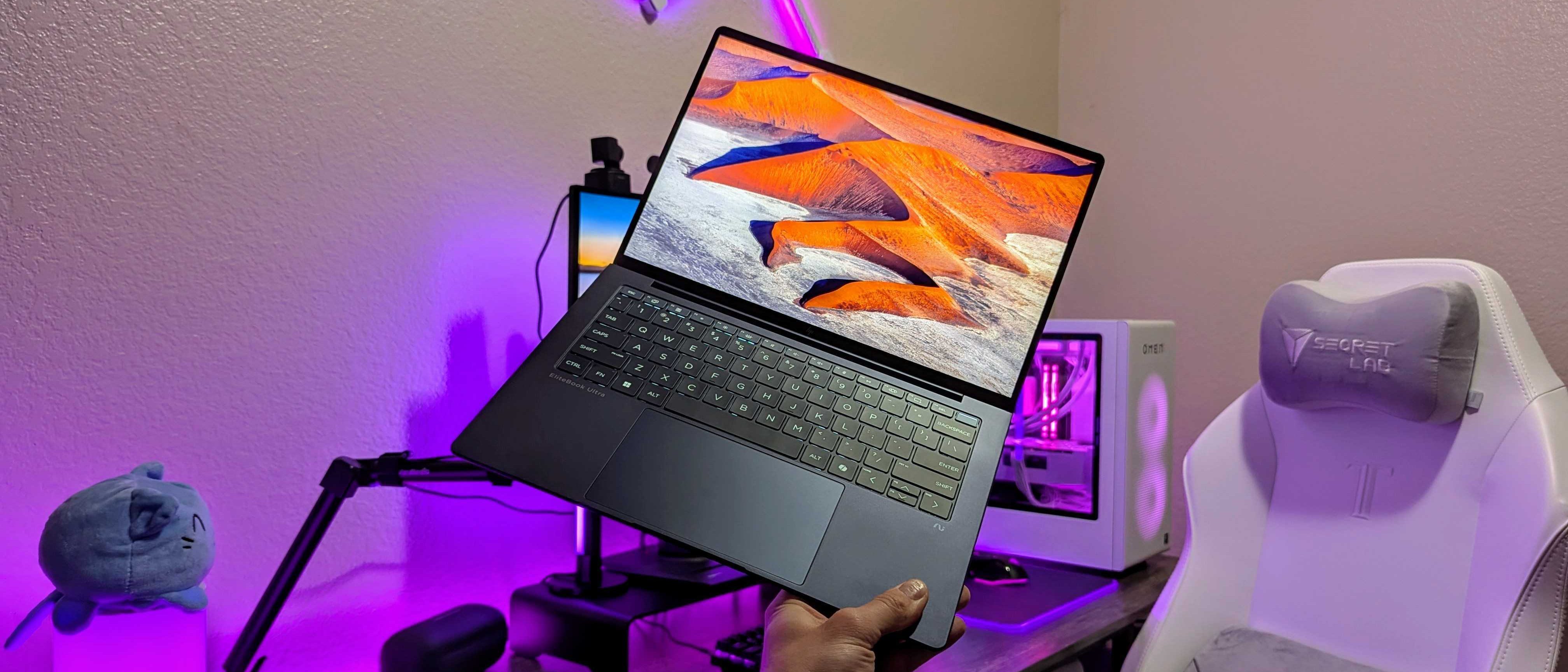Windows 10 May 2019 Update common problems and how to fix them
Installing the Windows 10 May 2019 Update should be an easy process, but if you're having problems, use this guide to troubleshoot and resolve them.
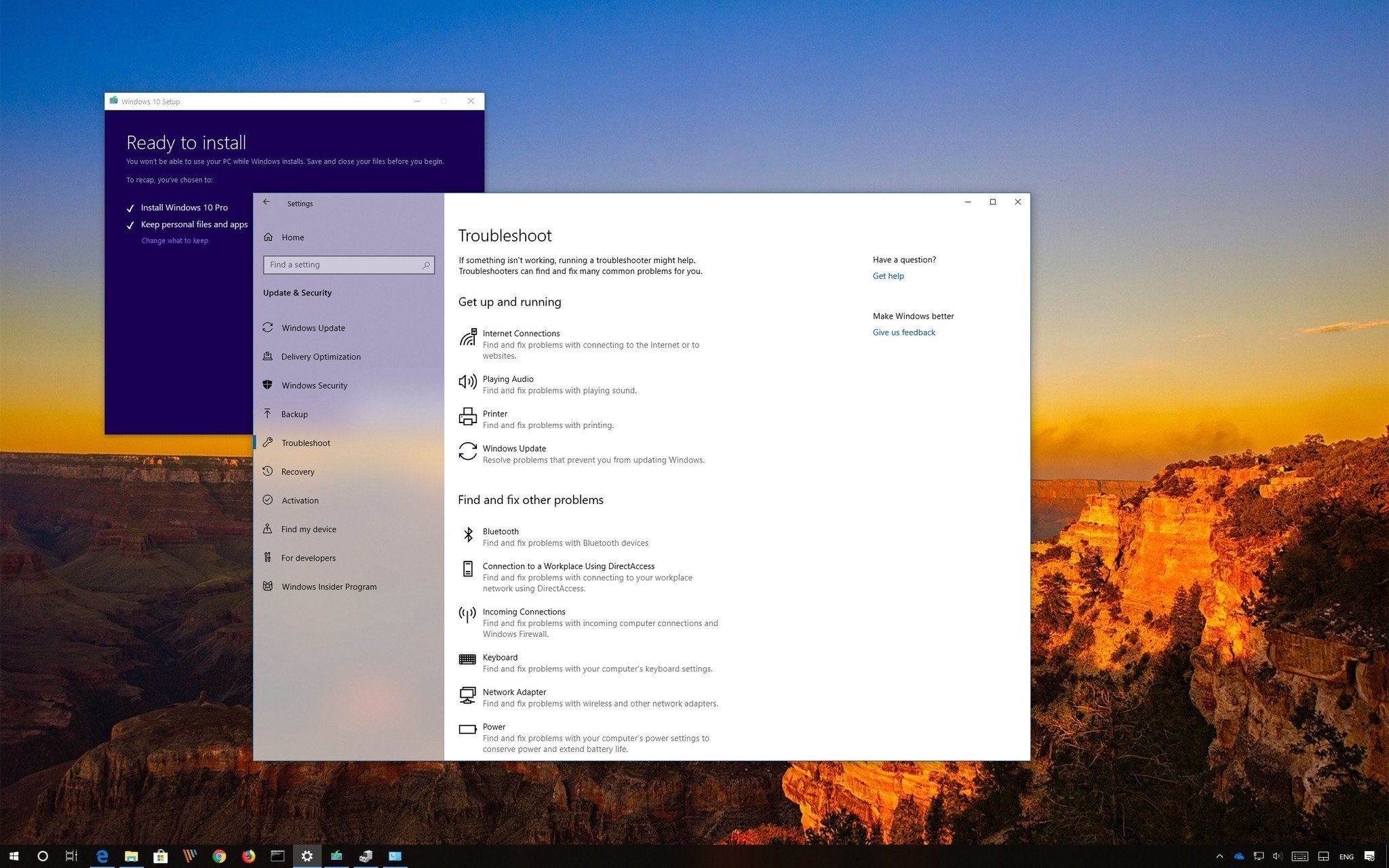
Microsoft is now rolling out the Windows 10 May 2019 Update (version 1903) to the masses with a slew of improvements and several new features to enhance your experience, whether you're using a desktop, laptop, or tablet. This is the seventh major update since the original launch, and it's the first semi-annual update of 2019 releasing to supported devices.
However, as a result of major code changes, a new feature update also means potential new issues during and after the upgrade that can negatively impact the overall usability and performance.
Also, consider that many of the problems moving to a new version aren't necessarily issues with the new version of Windows 10. A lot of times the reason for an installation failure is because of outdated drivers, conflicting applications, custom configurations, and hardware related issues.
In this Windows 10 guide, we'll dive into some of the problems and the instructions to resolve them as you make the leap to the May 2019 Update on your device.
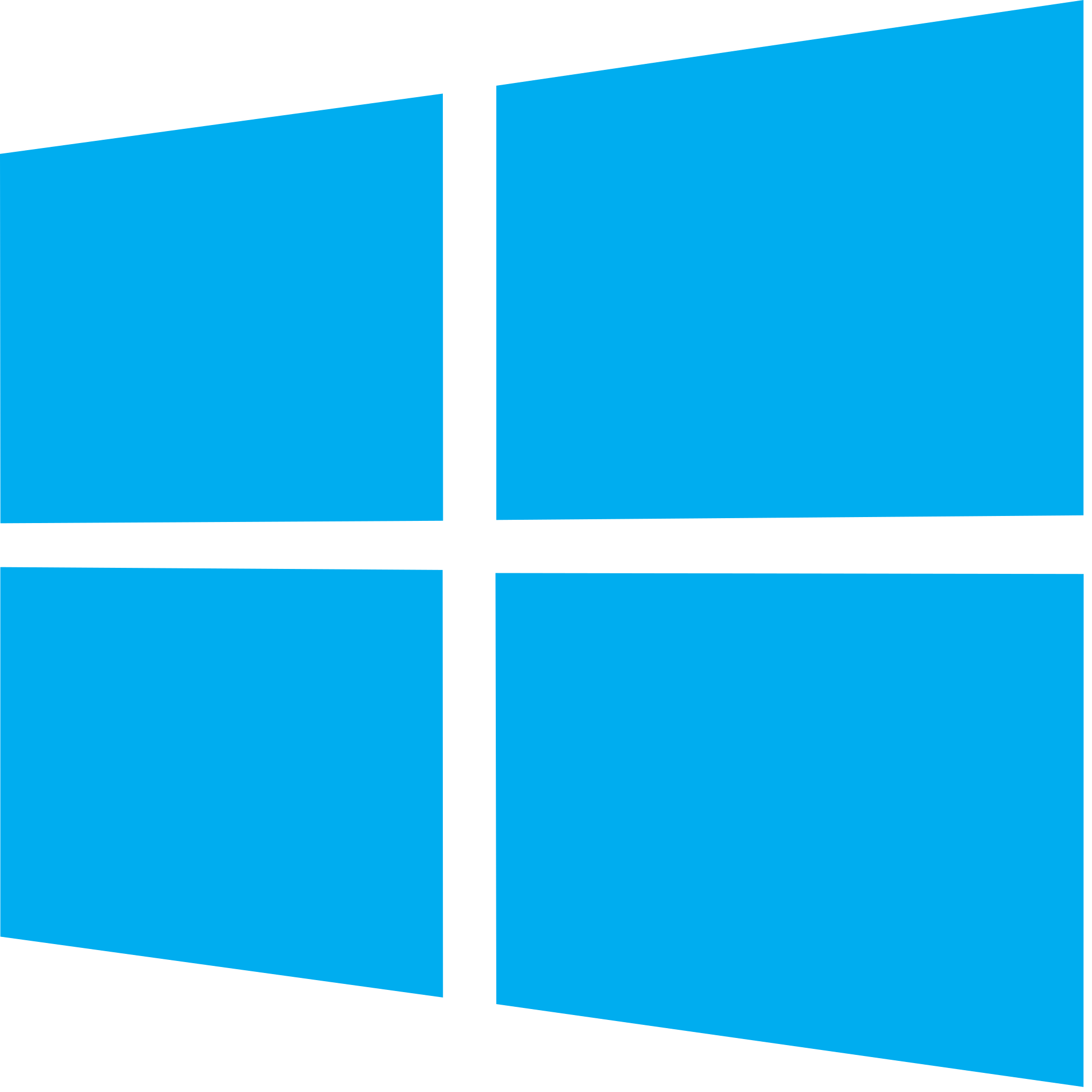
Windows 10 May 2019 Update full reviewHow to get the May 2019 Update ASAPMay 2019 Update common problems and how to fix themFull list of changes in the May 2019 UpdateAll of our May 2019 Update resources in one place
Windows 10 May 2019 Update fixes to common issues
Usually, when your device undergoes an upgrade to a new version, you may see two types of issues. You may come across errors that are known problems that can occur for many reasons, but they're not necessarily bugs with the May 2019 Update, and then there are those problems that are results of unknown bugs and compatibility problems with the latest feature update.
This guide highlights the steps to deal with both types of issues as you embark into the upgrade process and after the installation of Windows 10:
- How to fix unexpected errors installing the May 2019 Update using Windows Update
- How to fix error 0x800F0922 downloading the May 2019 Update using Windows Update
- How to fix install completion problems with the May 2019 Update
- How to fix error 0x80190001, 0x80073712, 0x80245006 installing the May 2019 Update files using Windows Update
- How to fix errors installing the May 2019 Update using Media Creation Tool
- How to fix issues installing the May 2019 Update using USB bootable media
- How to fix error 0x8007025D installing the May 2019 Update using ISO
- How to fix Update Assistant stuck downloading Windows 10 May 2019 Update
- How to fix error 0x8007042B or 0x800700B7 installing the May 2019 Update using the Windows Setup
- How to fix storage error 0x80070070, 0x80070008, or 0xC190020e installing the May 2019 Update
- How to fix hardware error 0xC1900200, 0xC1900202, or 0x80300024 installing the May 2019 Update
- How to fix driver error 0xC1900101 or 0x80090011 installing the May 2019 Update
- How to fix app compatibility error 0xC1900208 installing the May 2019 Update
- How to fix driver compatibility error 0x800F0923 installing the May 2019 Update
- How to fix error 0xC1900107 starting upgrade of the May 2019 Update
- How to fix account error 0x80070522 installing the May 2019 Update
- How to fix accidental restart error 0x80200056 installing the May 2019 Update
- How to fix activation problems with the May 2019 Update
- How to fix networking problems with the May 2019 Update
- How to fix black screen problems with the May 2019 Update
- How to fix error with external storage upgrading to the May 2019 Update
- How to fix Bluetooth issues after upgrading to the May 2019 Update
- How to fix Wi-Fi issues after upgrading to the May 2019 Update
- How to fix AMD RAID driver problems upgrading to the May 2019 Update
- How to fix brightness problem after upgrading to the May 2019 Update
- How to fix Dolby Atmos audio issues after upgrading to the May 2019 Update
- How to fix night light problems after installing the May 2019 Update
- How to fix duplicate user folders after installing the May 2019 Update
- How to fix intcdaud.sys error upgrading to the May 2019 Update
- How to fix Windows Sandbox error 0x80070002 with the May 2019 Update
- How to properly upgrade to the Windows 10 May 2019 Update
How to fix unexpected errors installing the May 2019 Update using Windows Update
While the recommended method to install a new version of Windows 10 is to use Windows Update, many times, you'll come across different error messages that will prevent you from completing the installation.
Get the Windows Central Newsletter
All the latest news, reviews, and guides for Windows and Xbox diehards.
Using this method, you can see a lot of different errors depending on the problem. However, if you don't know the cause of the issue, you can use the Windows Update troubleshooter to let the system fix the problem automatically.
To resolve errors with Windows Update to install the new feature update, use these steps:
- Open Settings.
- Click on Update & Security.
- Click on Troubleshoot.
- Under the "Get up and running" section, select the Windows Update option.
- Click the Run the troubleshooter button.
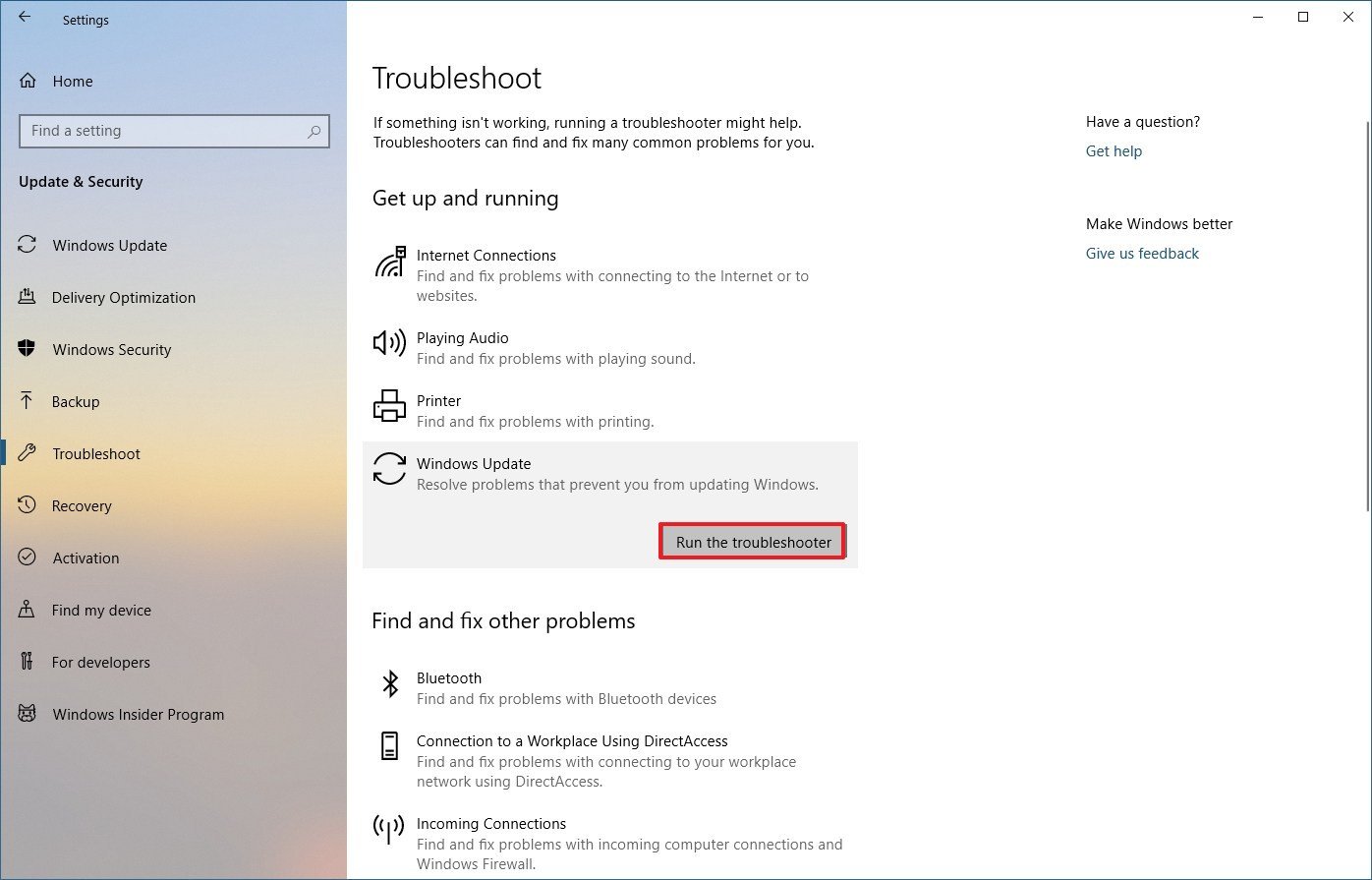
- Click the Apply this fix option (if applicable).
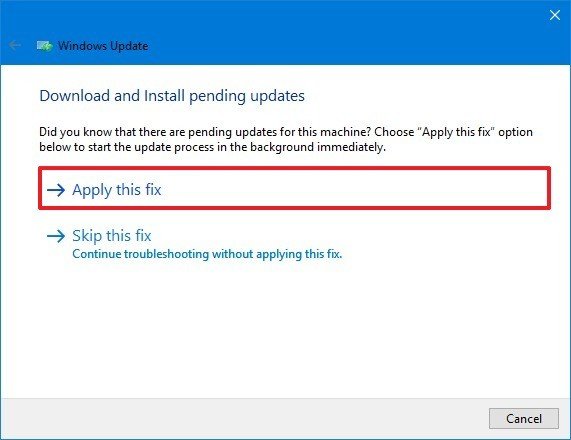
- Continue with the on-screen directions.
- Restart your computer.
Once you complete the steps, in the "Windows Update" settings page, click the Check for updates button to continue with the upgrade to version 1903.
In the case that Windows Update isn't working because of a networking issue, you may need to use the Network Adapter troubleshooter, under the "Find and fix other problems" section, in the "Troubleshoot" settings page to resolve the problem automatically.
How to fix error 0x800F0922 downloading the May 2019 Update using Windows Update
If you're seeing the error 0x800F0922 using Windows Update, then it could indicate that your device isn't able to connect to the update servers, or the System Reserved partition is out of space.
Terminating a VPN session
Usually, the 0x800F0922 error will appear when you're trying to download the files to install a new feature update while you're connected to a VPN server.
To resolve this issue, simply disconnect from the VPN section:
- Click the network icon in the taskbar.
- Select the VPN connection.
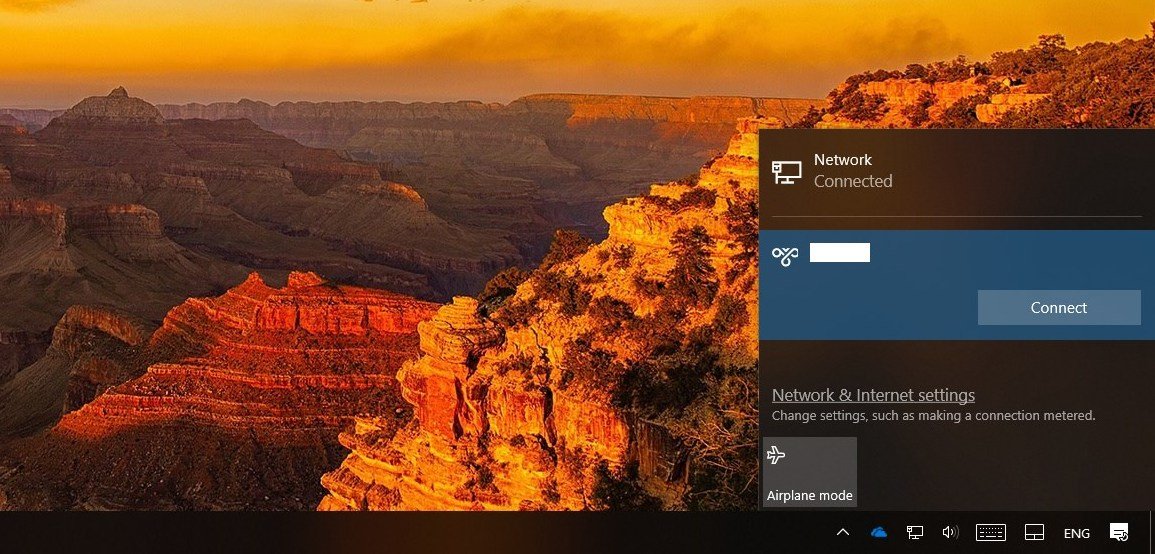
- Click the Disconnect button.
If you use a different VPN client, make sure to check the software vendor support website for more specific details to disconnect.
Modifying System Reserved partition
If you're using a third-party antivirus or another type of security software, sometimes they store data on the System Reserved partition, which can be the reason you're not able to install the May 2019 Update.
Usually, you can resolve this issue using a third-party tool to make the Reserved Partition bigger. (This partition should be 500MB or larger.)
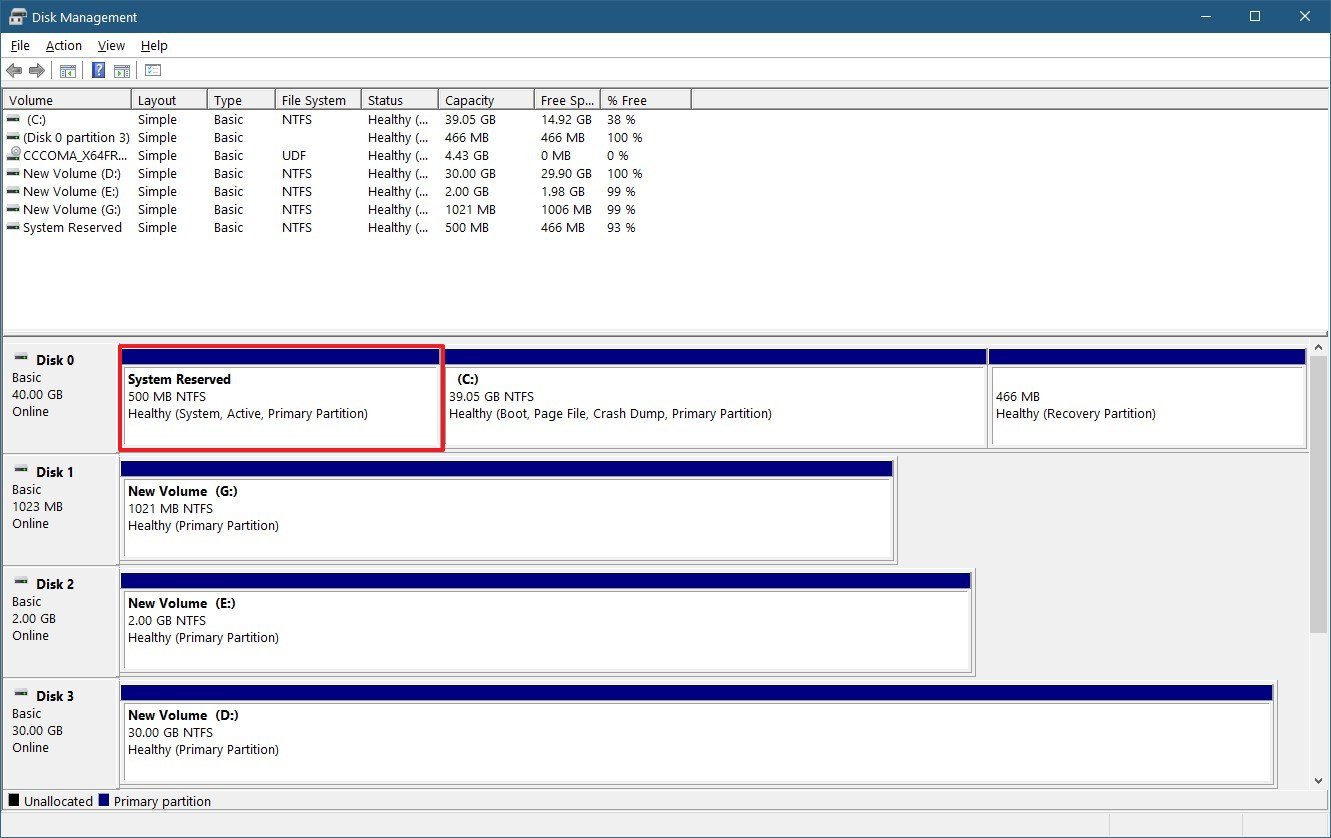
Alternatively, you can perform a clean installation with the new feature update, which will wipe out the hard drive and create the necessary partitions automatically.
How to fix install completion problems with the May 2019 Update
When using Windows Update to install a new version of Windows 10 or monthly update, there's a chance that you'll see one of these two errors:
- Error: We couldn't complete the updates. Undoing changes. Don't turn off your computer.
- Error: Failure configuring Windows Updates. Reverting changes.
These are common messages that can prevent the upgrade process from completing successfully, and you won't be able to continue until you investigate and fix the exact error.
Fortunately, the Windows Update settings page includes a section with information about each update that you're trying to install, and you can use this information to continue the investigation and fix the issue.
To find out the exact error that caused the upgrade process to fail, use these steps:
- Open Settings.
- Click on Update & Security.
- Click on Windows Update.
- Click the View your update history option.
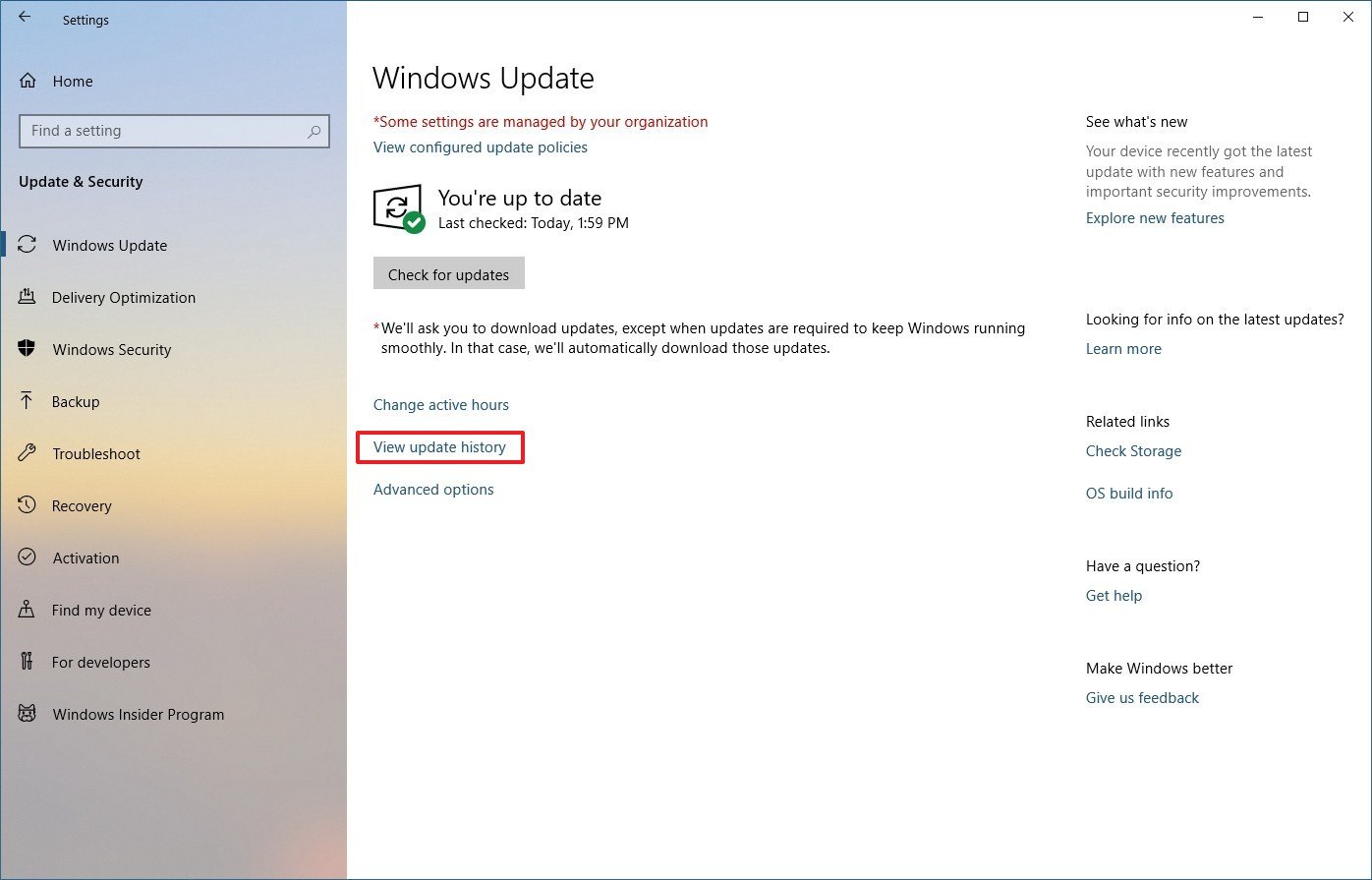
- Check the error code for the failed update.
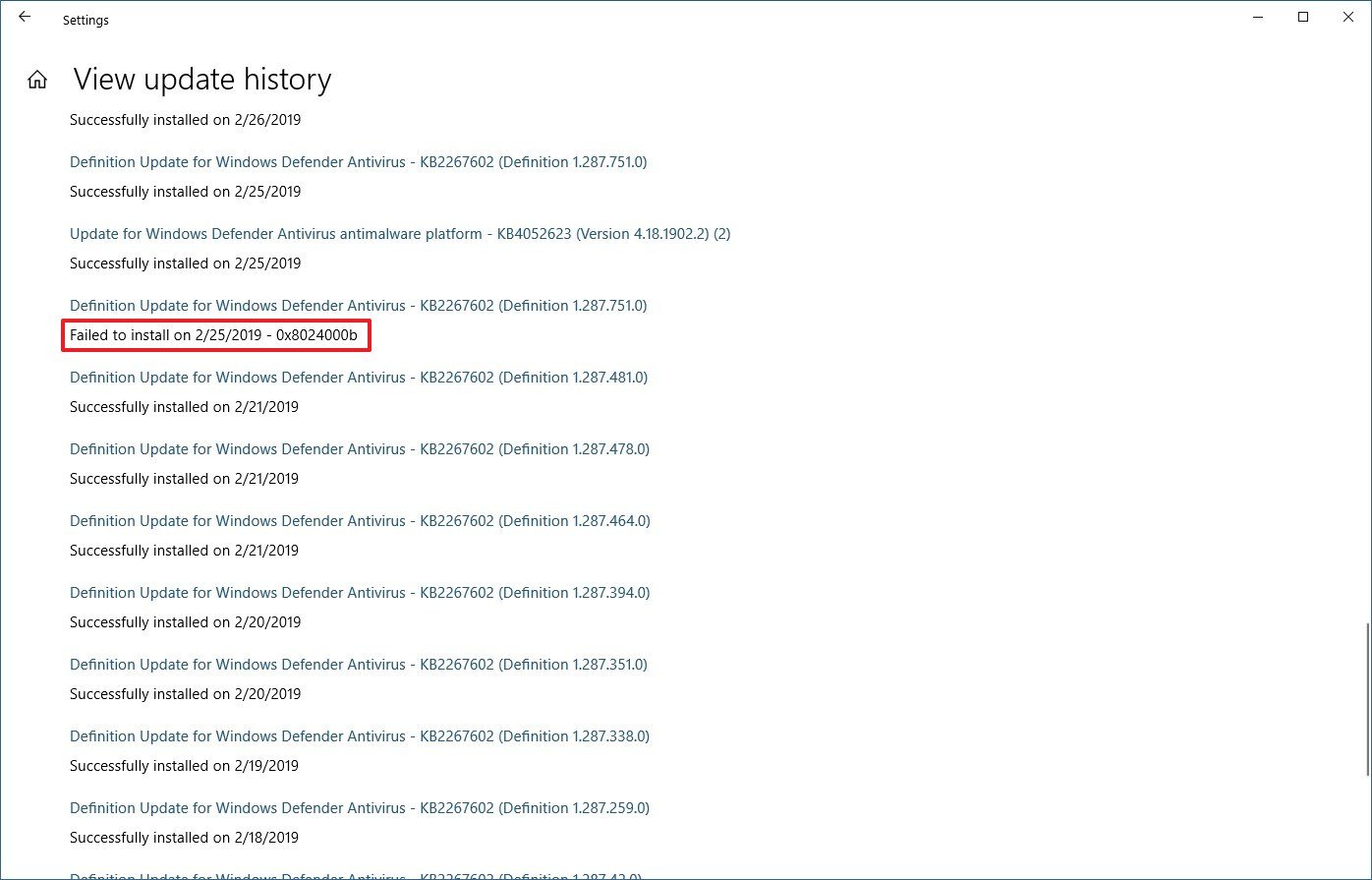
Once you complete the steps, you can use your preferred search engine to research the error, or better yet, you can ask in the Windows Central forums to find a solution for the problem.
Using Media Creation Tool
Using the Microsoft Media Creation Tool can also result on an error 0x80246007. If this is the case, then it means that the download didn't complete successfully.
To get around the issue, either try an in-place upgrade again or use the tool to start from scratch with a clean copy of Windows 10.
How to fix error 0x80190001, 0x80073712, or 0x80245006 installing the May 2019 Update files using Windows Update
If you get the 0x80190001 error, it means that a problem has occurred during the download process. If you see error 0x80073712 or 0x80245006 trying to install the new feature update, it indicates that some of the upgrade files are either damaged or missing.
The easiest way to fix this issue is to use the Storage settings to delete the temporary install files and then go through the upgrade process again.
To clean downloaded temporary files on Windows 10, use these steps:
- Open Settings.
- Click on System.
- Click on Storage.
- Under the "Storage sense" section, click the Free up space now option.
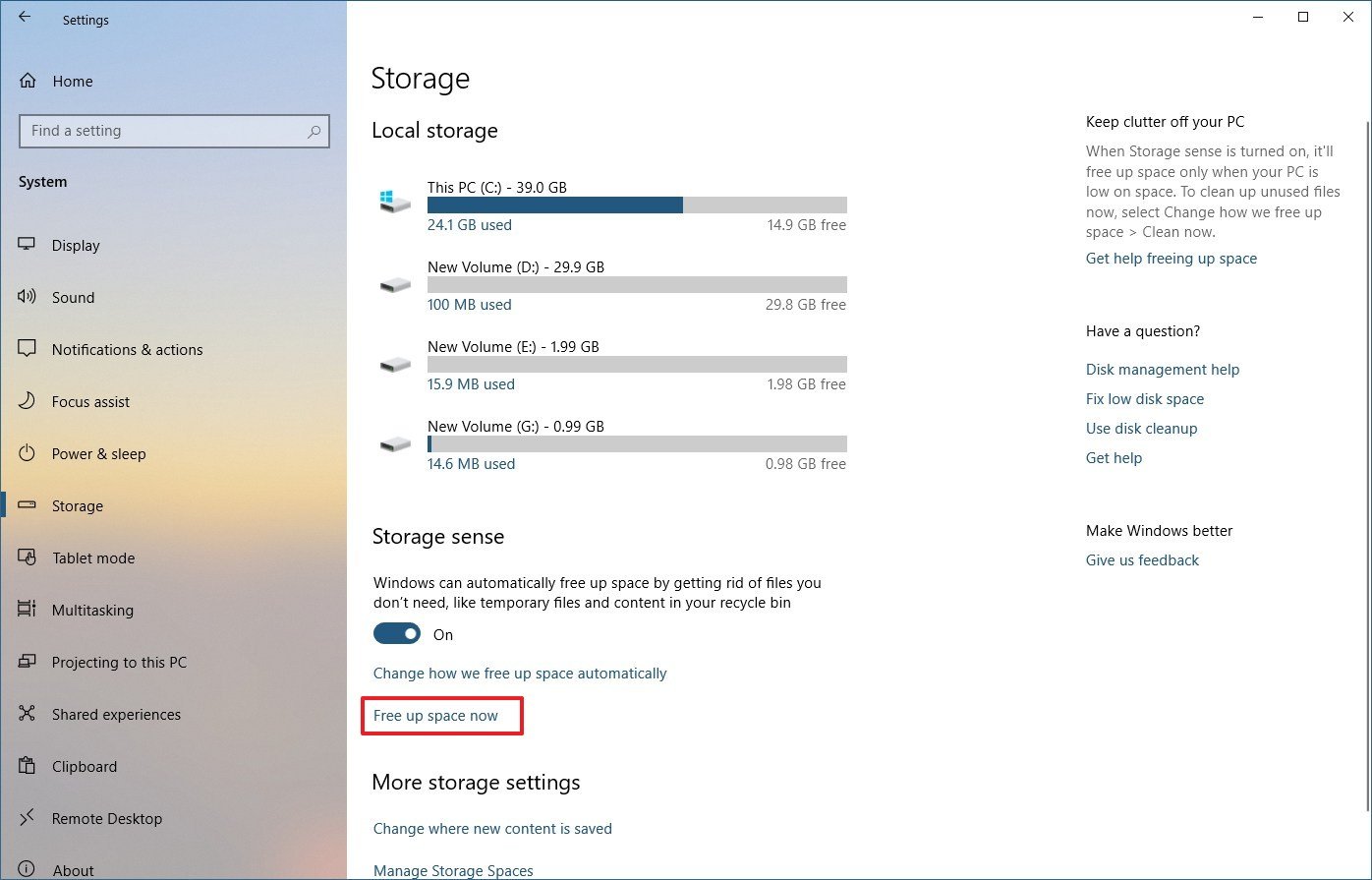
- Clear the default selections.
- Check the Temporary Windows installation files or Windows Setup temporary files option.
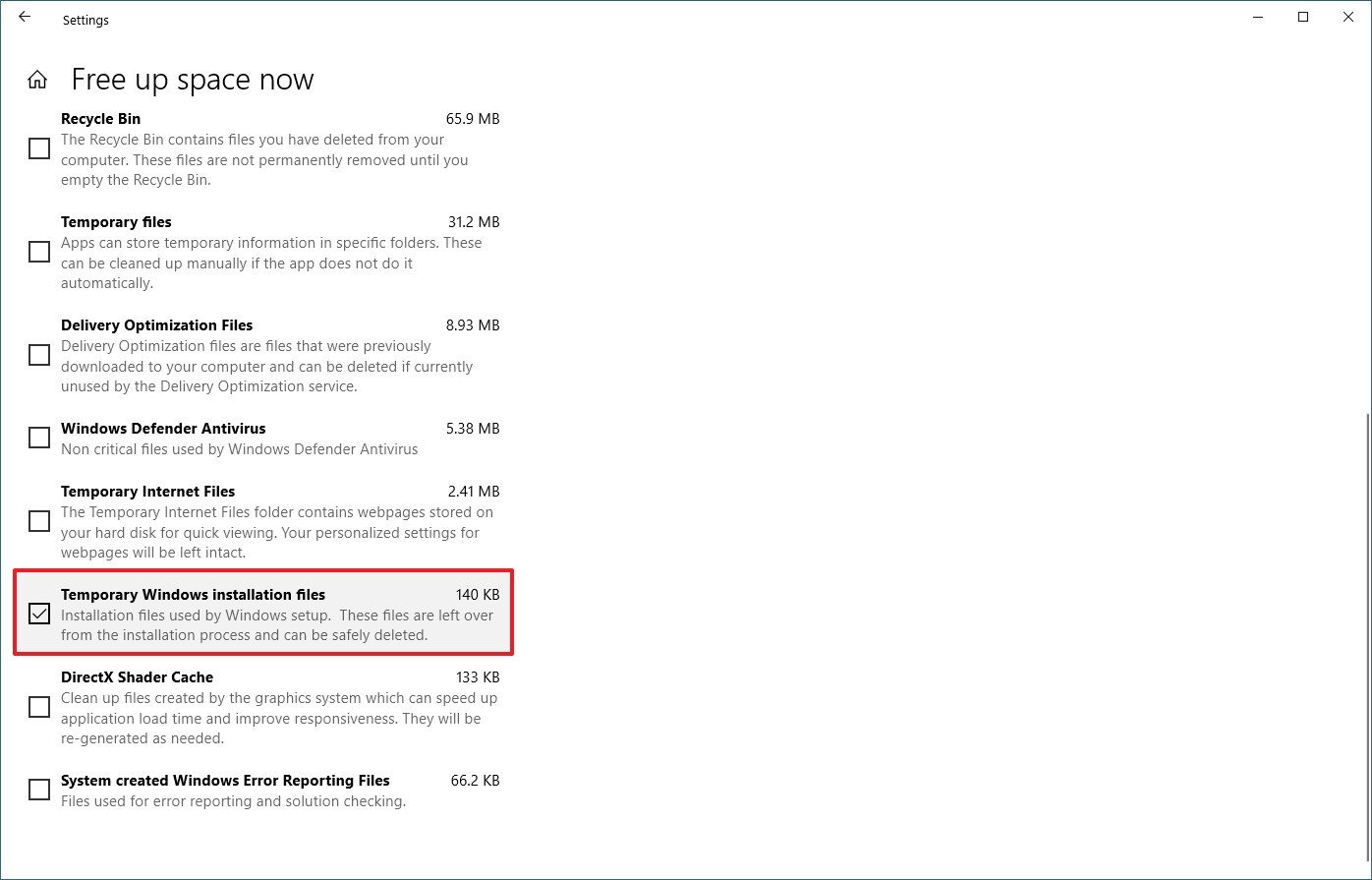
- Click the Remove files button.
After completing the steps, in the "Windows Update" settings page, click the Check for updates button to proceed with the upgrade to the May 2019 Update.
Alternatively, you can avoid this issue using the Media Creation Tool to perform a clean installation of Windows 10 with the new feature update.
How to fix errors installing the May 2019 Update using Media Creation Tool
The Media Creation Tool is a handy utility to perform an in-place upgrade or create a bootable media to install a new version of Windows 10, such as the May 2019 Update. However, you can end up with a Dynamic Update problem, which can prevent the tool from starting the upgrade process even after restarting it.
If after restarting the Media Creation Tool, the upgrade files get stuck downloading, you may need to start the installation process manually using these steps:
- Open File Explorer.
- Browse to the following path:
C:\$Windows.~BT\Sources - Double-click the Setupprep.exe file to start the upgrade.
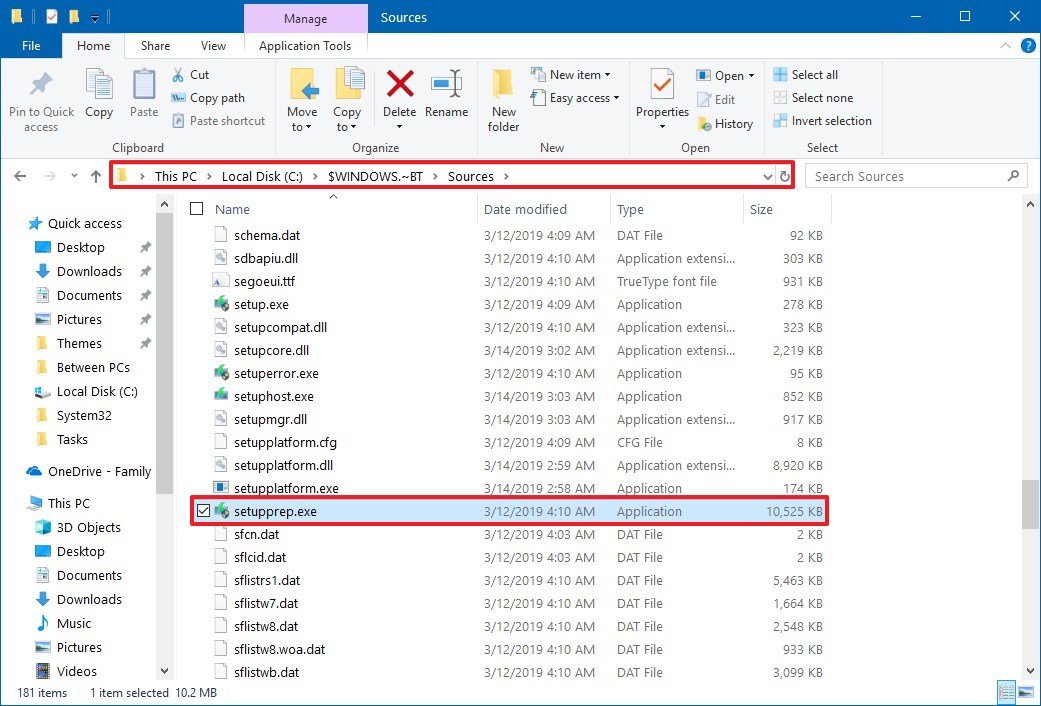
Once you complete the steps, you should be able to continue with the upgrade process to the May 2019 Update. If you're still seeing the same problem, then you should try the Update Assistant.
Fixing Media Creation Tool stuck downloading updates
As part of the upgrade process, the Media Creation Tool downloads the files required to upgrade, and then check for additional updates.
If the tool gets stuck checking for the update before the upgrade, use these steps:
- Restart the Media Creation Tool.
- As soon as the installation files finish downloading, unplug the network cable from your computer or disconnect from the wireless network.
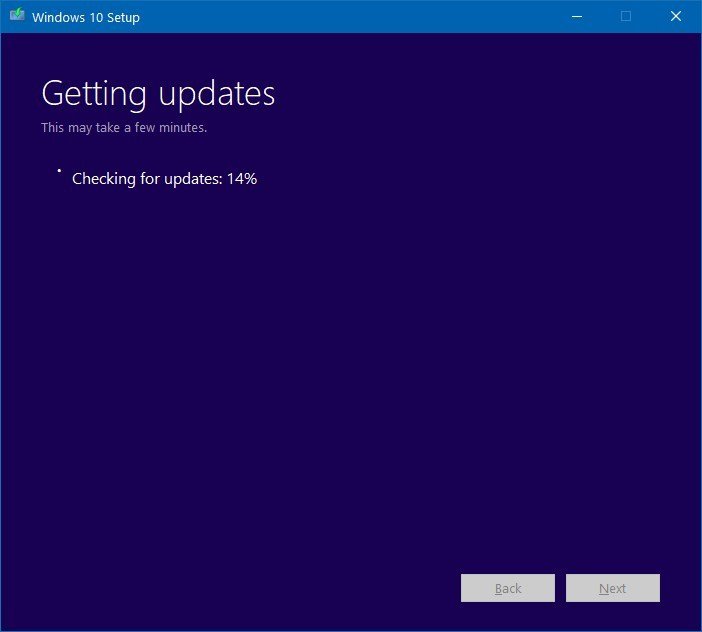
After you complete the steps, the tool will timeout, skip the updates, and it'll continue with the upgrade process.
How to fix issues installing the May 2019 Update using USB bootable media
If you're planning to upgrade your device using a USB media created with the Media Creation Tool, the Windows 10 May 2019 Update may fail every time you try the installation process.
Typically, this happens because some of the files may be damaged or missing inside the USB flash drive. To fix this problem, use the Media Creation Tool one more time to recreate the bootable media. (If available, try creating the installation media using another computer.)
To create a USB media, use these steps:
- Download the Media Creation Tool from Microsoft. (Use the Download tool now button.)
- Double-click the MediaCreationToolxxxx.exe file to start the utility.
- Click the Accept button.
- Select the Create installation media (USB flash drive, DVD, or ISO file) for another PC option.
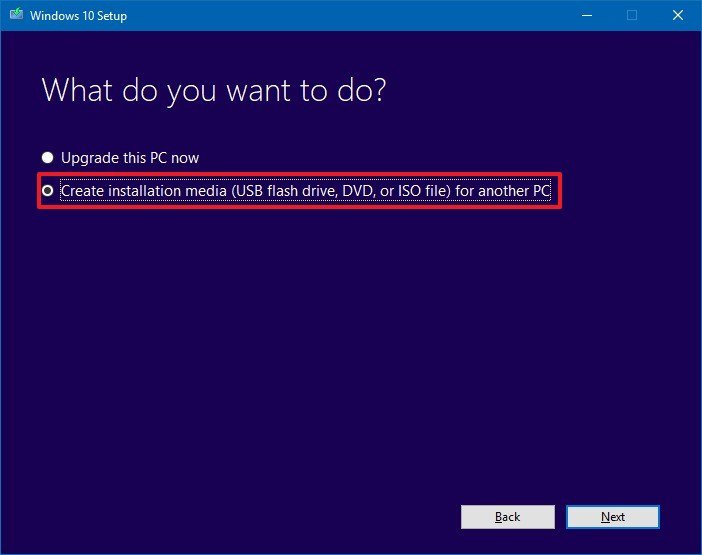
- Click the Next button.
- Select your language, architecture, and edition settings, if different from the default selection.
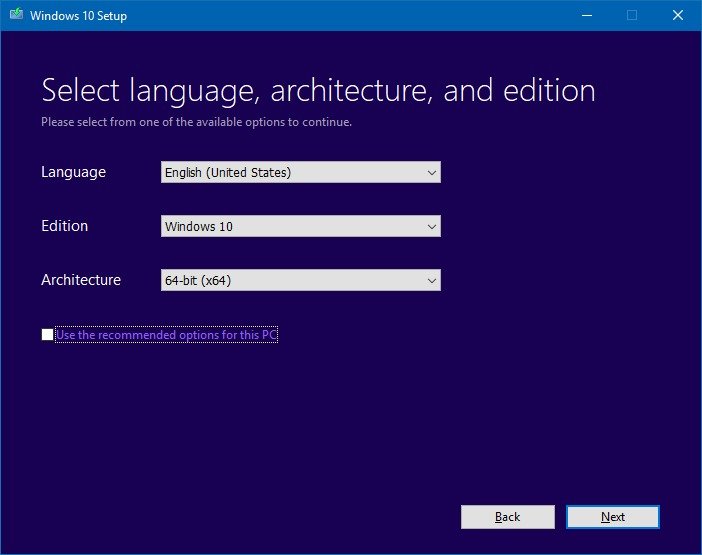
- Click the Next button.
- Select the USB flash drive option.
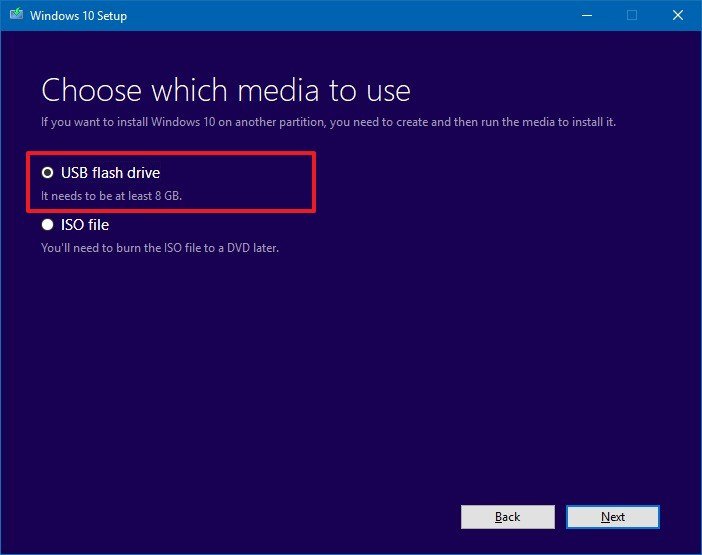
- Click the Next button.
- Select a removable drive from the list.
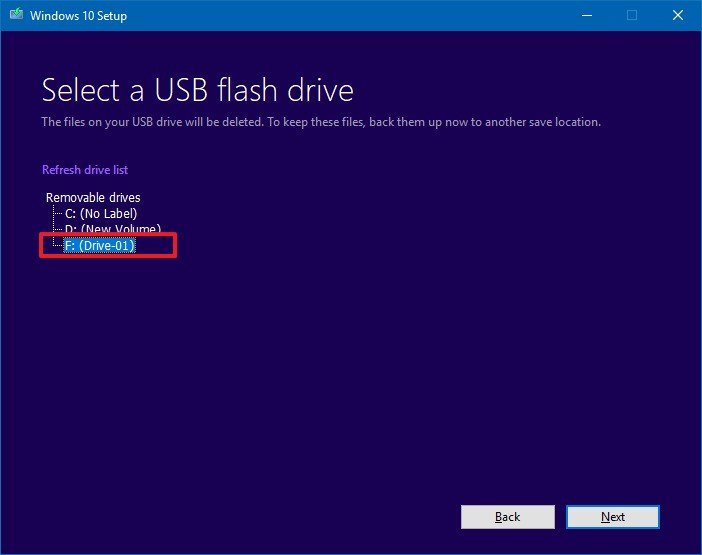
- Click the Next button.
- Click the Finish button.
Once you complete the steps, you'll end up with a brand-new USB media without corrupted files, which you can now use to install the Windows 10 May 2019 Update.
How to fix error 0x8007025D installing the May 2019 Update using ISO
In the case that you see the 0x8007025D - 0x2000C error during the upgrade process, then some of the files may be corrupted in the Windows 10 ISO file.
To fix this problem, use the Media Creation Tool to create a new Windows 10 ISO file with these steps:
- Download the Media Creation Tool from Microsoft. (Use the Download tool now button.)
- Double-click the MediaCreationToolxxxx.exe file to launch the utility.
- Click the Accept button.
- Select the Create installation media (USB flash drive, DVD, or ISO file) for another PC option.

- Select your language, architecture, and edition settings, if different from the default selection.

- Click the Next button.
- Select the ISO file option.
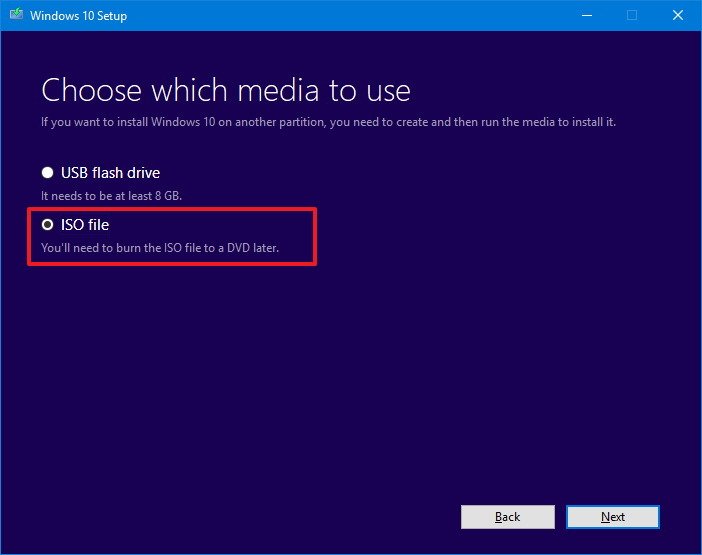
- Click the Next button.
Once you complete the steps, the utility will create a new ISO file that should now work to upgrade your computer or virtual machine.
How to fix Update Assistant stuck downloading Windows 10 May 2019 Update
While the Update Assistant tool has been designed to install feature updates when Windows Update isn't working, sometimes, the utility can run into problems of its own, including getting stuck during the update download process.
Typically, the issues that can occur using the Update Assistant are associated with network problems. If this is the case, you can use these tips to fix the problem:
- Restart your device, and then try the Update Assistant again.
- Disconnect the network cable from your computer, or disable your network connection. Wait around one minute, reconnect to the network, and use the Update Assistant one more time.
If you're still dealing with the same problem, use the Media Creation Tool to upgrade your device to the May 2019 Update.
How to fix error 0x8007042B or 0x800700B7 installing the May 2019 Update using the Windows Setup
As you try to upgrade to Windows 10 version 1903 using the Media Creation Tool, USB install media, or Update Assistant, you may experience the error 0x8007042B 0x4000D, along with the "Something went wrong" message, or error 0x800700B7 0x2000A which will prevent the installation of the feature update.
Usually, the error 0x8007042B 0x4000D or 0x800700B7 0x2000A indicate that the Windows Setup cannot continue as a result of another process running in the background. For instance, the setup can stop unexpectedly because of a third-party security software (such as antivirus), or a process for certain applications.
To get around this problem, either identify and terminate the application and its background processes and start again. Uninstall the programs that may be causing the issue (such as antivirus or anti-spyware). Or perform a clean boot of Windows 10 and try the upgrade process one more time.
To uninstall applications on Windows 10, use these steps:
- Open Settings.
- Click on Apps.
- Click on Apps & features.
- Select the app you want to remove, and click the Uninstall button.
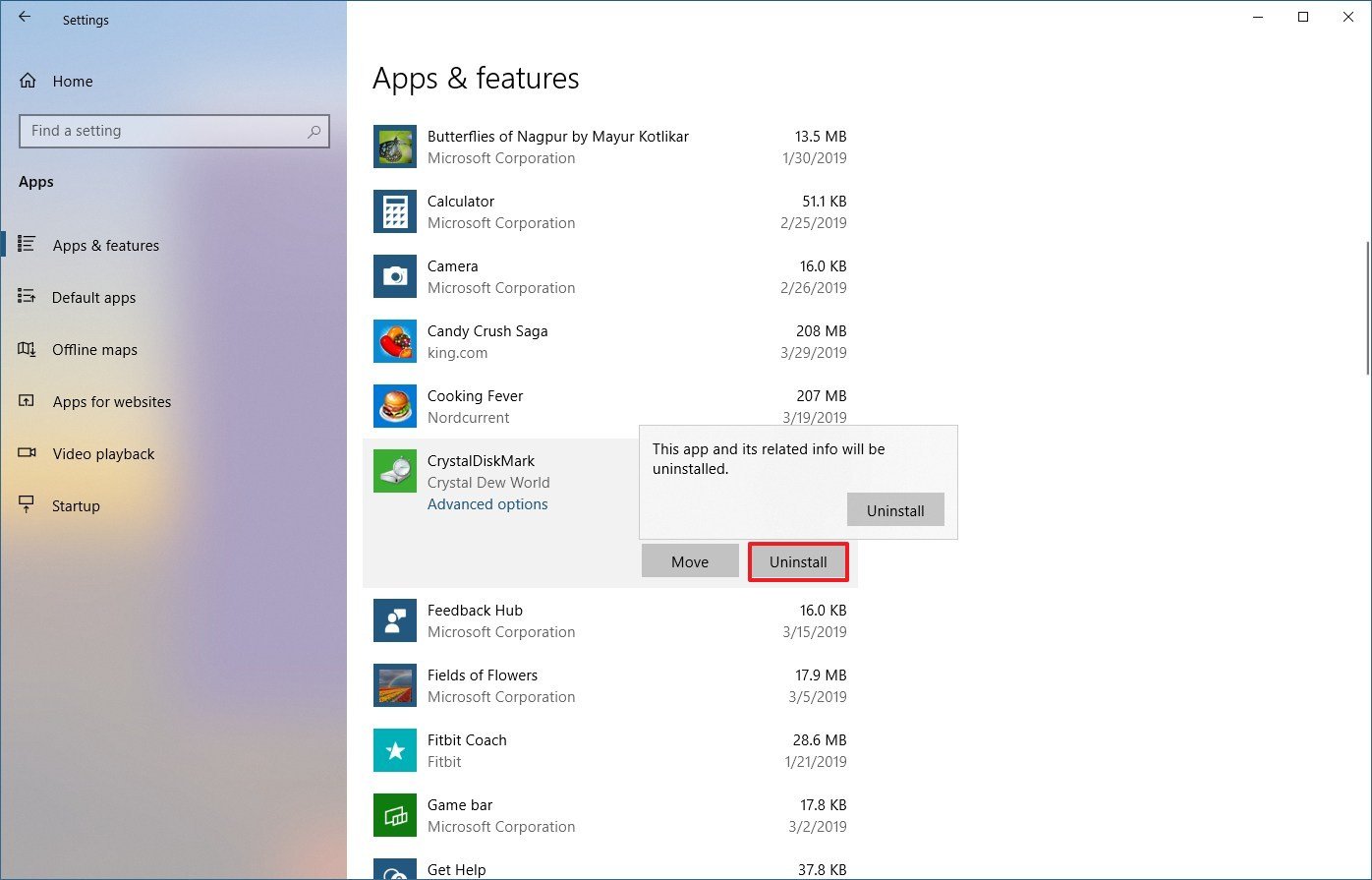
- Click the Uninstall button again to confirm.
After you complete the steps, use the same instructions again to remove any other conflicting apps. (After the installation, remember to reinstall the third-party software.)
How to fix storage error 0x80070070, 0x80070008, or 0xC190020e installing the May 2019 Update
As part of the minimum hardware requirements, you need at least 20GB of available storage to upgrade a 64-bit version or 16GB of space for a 32-bit version. If your device doesn't meet the storage requirements, you may get one of the following error messages:
- 0x80070070 – 0x50011
- 0x80070070 – 0x50012
- 0x80070070 – 0x60000
- 0x80070008
- 0xC190020e
To resolve the storage problem installing the May 2019 Update, use the Settings app to free up space using these steps:
- Open Settings.
- Click on System.
- Click on Storage.
- Under section "Storage sense" section, click the Free up space now option.

- Select the files you want to delete to reclaim space, including:
- Windows Upgrade log files.
- System created Windows Error Reporting Files.
- Windows Defender Antivirus.
- Windows Update Cleanup.
- Thumbnails.
- Temporary Windows installation files.
- Temporary files.
- Recycle Bin.
- Temporary Internet Files.
- Delivery Optimization Files.
- DirectX Shader Cache.
- Click the Remove files button.
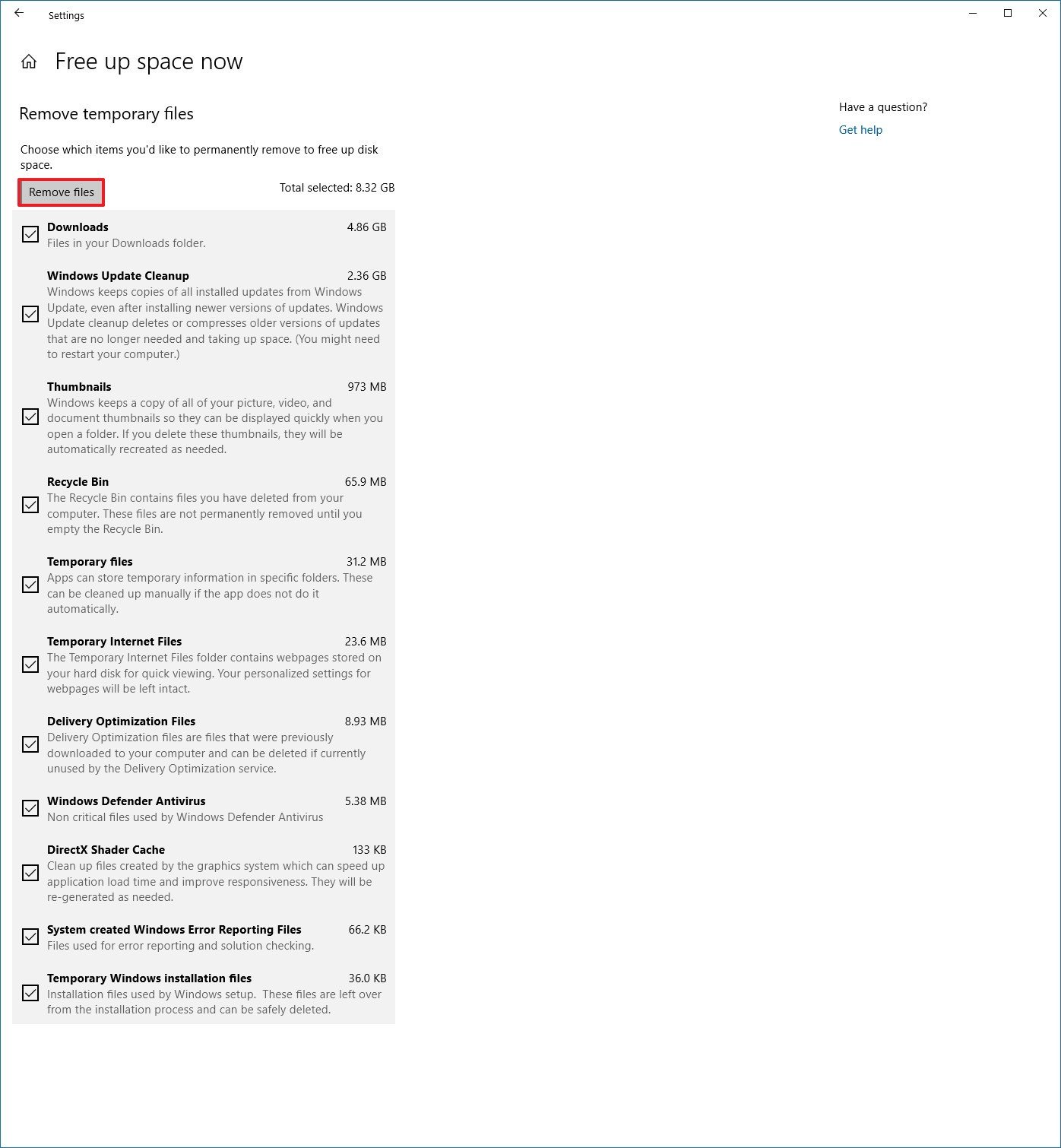
Once you complete the steps, if you're able to clear enough space, you should be able to install Windows 10 version 1903 without problems.
Alternatively, you can connect an external storage (such as an external hard drive or USB flash drive) with at least 16GB of storage, and then, Windows 10 will use it as temporary storage to perform the installation.
How to fix hardware error 0xC1900200, 0xC1900202, or 0x80300024 installing the May 2019 Update
Although Windows 10 can run in most hardware configurations, you may stumble upon error 0xC1900200 – 0x20008, 0xC1900202 – 0x20008, or 0x80300024, if the device doesn't meet the minimum requirements.
If you're about to install Windows 10 with the May 2019 Update, make sure the device includes these minimum hardware requirements:
- CPU: 1GHz.
- Memory: 2GB for 32 bit or 64 bit.
- Disk: 16GB for 32 bit or 20GB for 64 bit.
- Graphics: DirectX 9 or later with WDDM 1.0 driver.
- Display: 800x600.
While you may not see errors on high-end computers, it could be an issue on low-end devices. In the case that the 0xC1900200 – 0x20008 or 0xC1900202 – 0x20008 error comes up, the problem is likely to be not enough RAM, which you can resolve installing additional memory.
You can use this guide to find out the hardware information of your device to determine if a hardware upgrade is required.
Fixing error 0x80070002 0x20009
Another common problem while trying to install a new version of Windows 10 is error 0x80070002 0x20009, which indicates that the system is unable to find the specific files.
Usually, this error happens when you have more than one drive connected to your computer. To quickly fix the problem, disconnect secondary internal drives as well as external drives (including USB flash drives). You only need the main drive that will house the Windows 10 installation and the drive that contains the installation files.
How to fix driver error 0xC1900101 or 0x80090011 installing the May 2019 Update
When installing the May 2019 Update, if you come across one of the 0xC1900101 or 0x80090011 errors, then you're dealing with a driver issue.
Here's a list of possible variants of the error:
- 0xC1900101 - 0x20004
- 0xC1900101 - 0x2000c
- 0xC1900101 - 0x20017
- 0xC1900101 - 0x30018
- 0xC1900101 - 0x3000D
- 0xC1900101 - 0x4000D
- 0xC1900101 - 0x40017
To overcome the problem, you can use the following solutions:
Disconnect peripherals
One way to avoid errors with drivers is to disconnect the peripheral preventing your device from upgrading. After installing the feature update, you can reconnect them again.
Usually, it's always recommended to disconnect all peripherals that aren't essential to complete the installation, including external drives, printers, Bluetooth devices, USB devices, cameras, and other peripherals to prevent issues.
Free up storage
Available space can be one of the reasons for one of the 0xC1900101 errors. If this is the case, use Storage sense, remove non-essential apps and games, and delete (or export) personal files to free up space.
If you need more assistance, use this guide to reclaim as much storage as possible.
Update device drivers
In the case that your computer is getting one of the 0xC1900101 or 0x80090011 error, make sure you're using the most up-to-date drivers from your manufacturer.
To install the latest driver updates on your computer, use these steps:
- Open Start.
- Search for Device Manager, and click the top result to open the experience.
- Expand the branch with the device causing issues. (Typically, it'll have a yellow exclamation mark.)
- Right-click the device, and select the Update driver option.
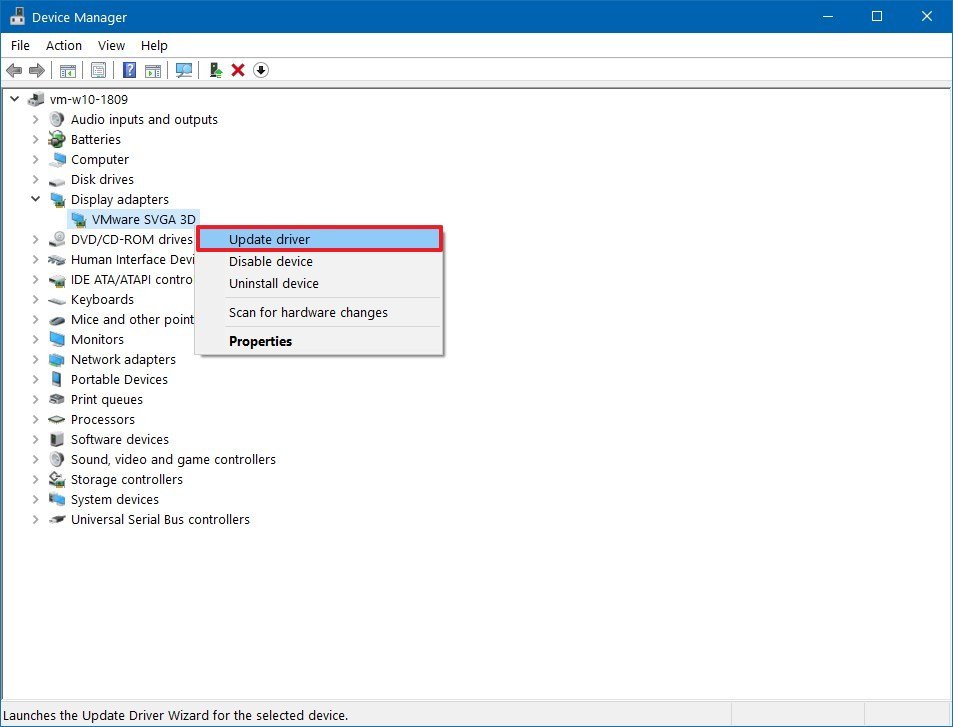
- Click the Browse my computer for driver software option. (Or click the Search automatically for updated driver software option to check for updates automatically.)
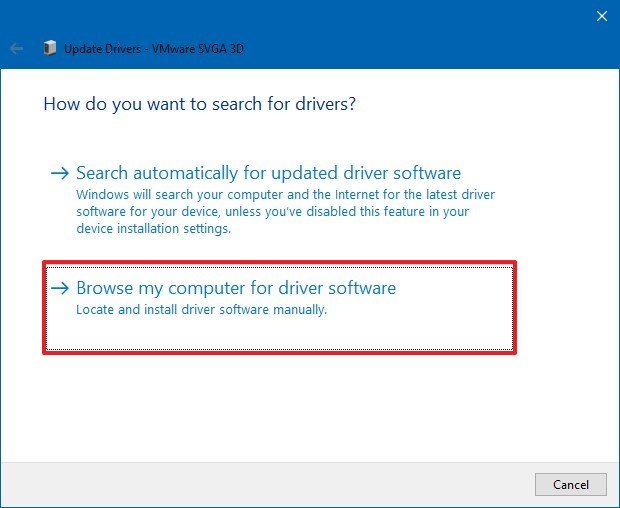
- Select the location of the unpacked folder with the driver files.
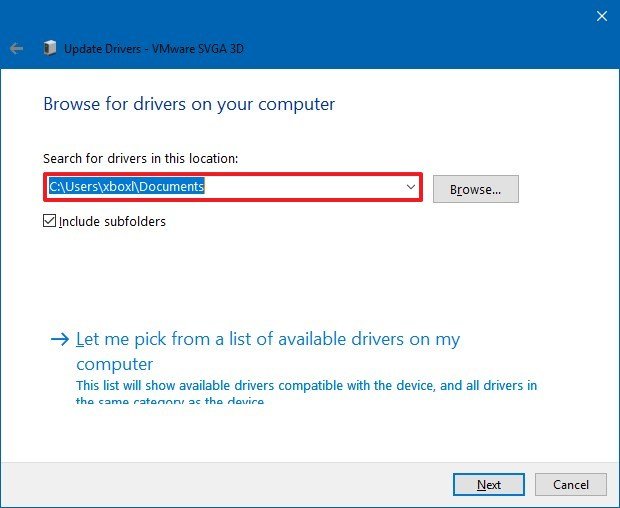
- Click the Next button.
- Continue with the on-screen directions.
If you're downloading the driver from your manufacturer support website, skip the above instructions, and make sure to use their steps to install the update.
Repair main drive
You can also use the CHKDSK command line tool to check and fix logical and physical errors on the hard drive that could be preventing your device from upgrading correctly.
To repair errors inside the hard drive, use these steps:
- Open Start.
- Search for Command Prompt, right-click the top result, and select the Run as administrator option.
- Type the following command and press Enter:
chkdsk/f c:
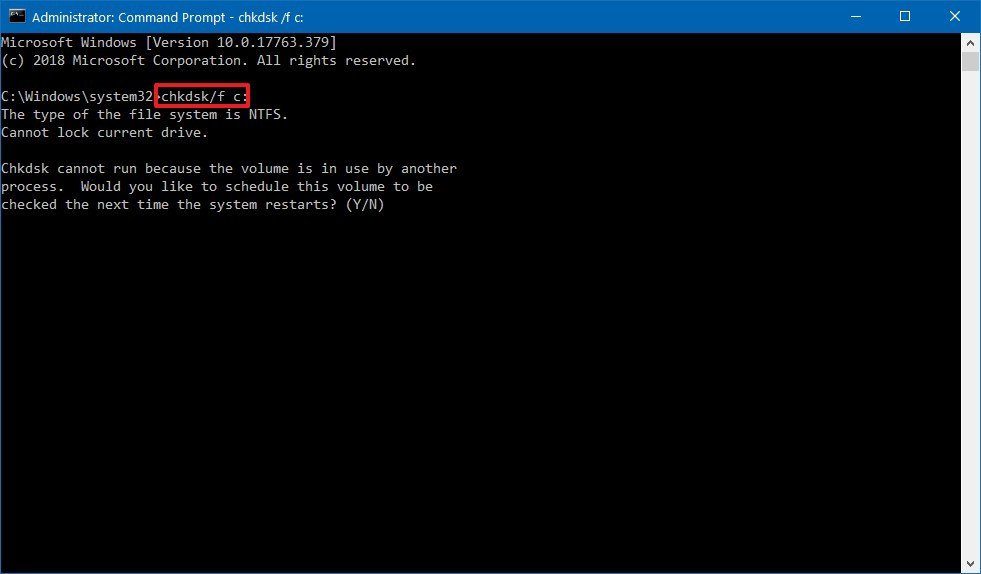
- Type Y and press Enter to schedule a scan.
- Restart your computer.
Once you complete the steps, during the startup process, the CHKDSK tool will scan and repair any errors that it may find on the hard drive.
Resolve issues with current installation
Windows 10 ships with the System File Checker (SFC) and Deployment Servicing and Management (DISM) tools, which can help you repair problems with your device current installation that can help to avoid seeing 0xC1900101 errors.
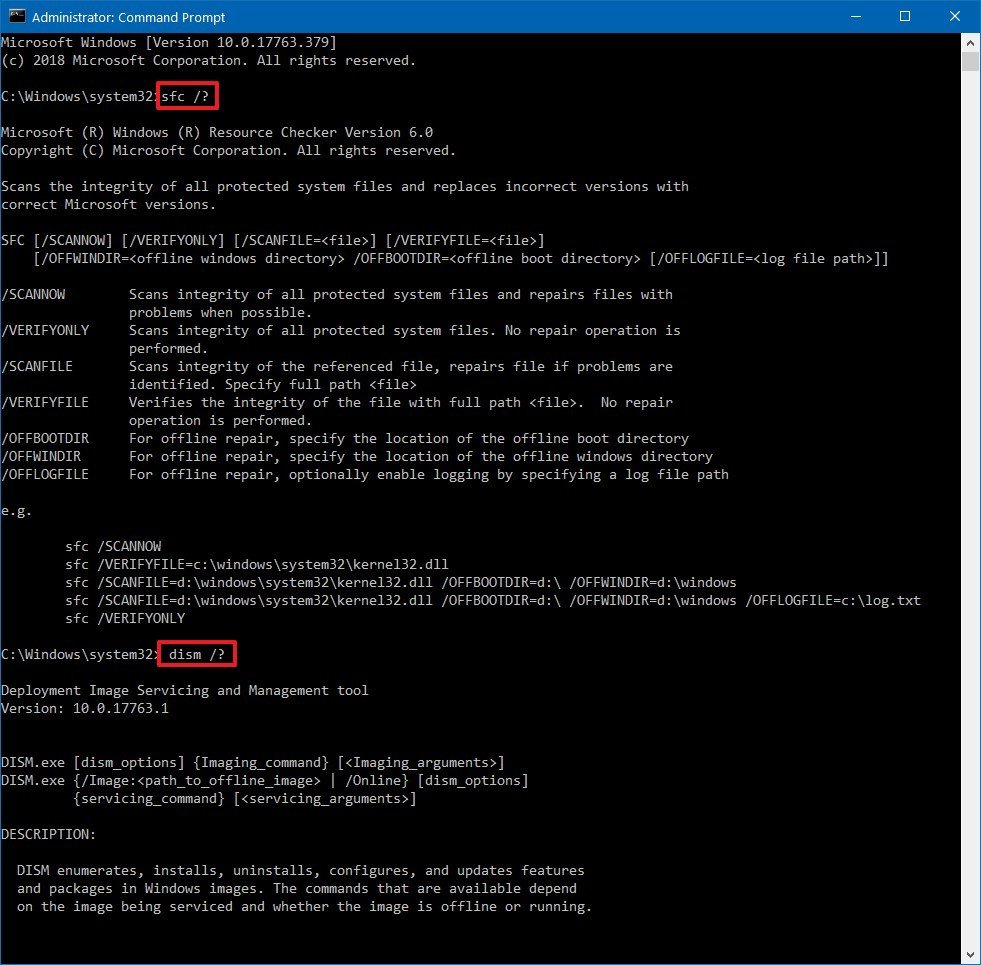
You don't need to use both tools. You should start with the SFC tool in Command Prompt, and if you continue having issues, then you should try the DISM command tool to fix problems with the current installation.
Update device manually
In the case that you've tried everything, and you're still running into the same issue, an alternative option includes performing a clean installation of Windows 10 with the May 2019 Update using the Media Creation Tool.
How to fix app compatibility error 0xC1900208 installing the May 2019 Update
When upgrading to the May 2019 Update, you may also see error 0xC1900208 – 0x4000C, which reveals that some of your installed applications are incompatible with the installation process.
To address this issue, uninstall the apps that may be blocking the installation (such as non-Microsoft antivirus, anti-spyware, and other security software).
You can remove apps from your computer using these steps:
- Open Settings.
- Click on Apps.
- Click on Apps & features.
- Select the app causing the problem.Quick tip: If you don't know the app causing the problem, usually, the problem is the antivirus and older software.
- Click the Uninstall button.

- Click the Uninstall button again.
After you complete the steps, you should be able to finish the installation of Windows 10 version 1903 without problems.
How to fix driver compatibility error 0x800F0923 installing the May 2019 Update
When you see error 0x800F0923, it means that there's a compatibility problem with a device driver or program installed on your computer.
Usually, you'll see this error when there's an issue with the graphics driver. It can also be a compatibility problem with an old piece of software or third-party antivirus. Or one of the components inside your computer is using an outdated driver.
If you stumble upon the error 0x800F0923, you can use the Media Creation Tool or Update Assistant tool. These tools can detect and show you a report of any common hardware compatibility issue.
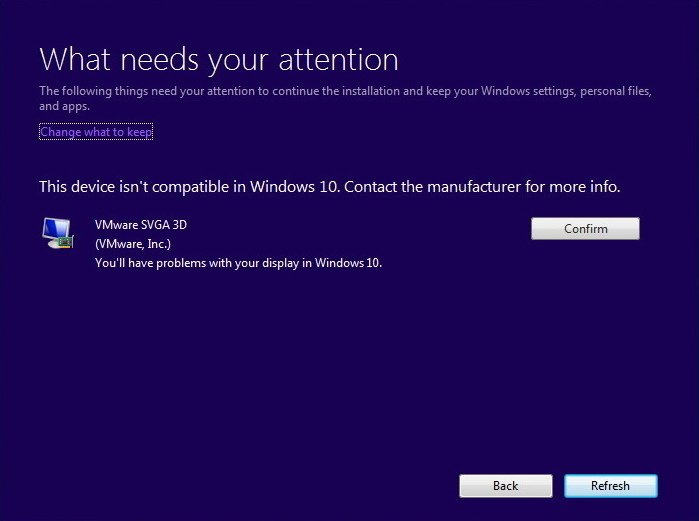
In the case that it's a driver problem, it's recommended to download and install the most up-to-date driver available from your manufacturer support website, using their instructions.
Quick tip: Sometimes manufacturers also offer beta versions of their drivers, which may fix the problem in question.
If the device is using the latest driver, you can try uninstalling it, then continue with the version 1903 installation. After the upgrade, you can re-install the driver again.
To quickly remove a device driver on Windows 10, use these steps:
- Open Start.
- Search for Device Manager, and click the top result to open the experience.
- Expand the branch that contains the device with the problematic driver.
- Right-click it, and select the Uninstall device option.
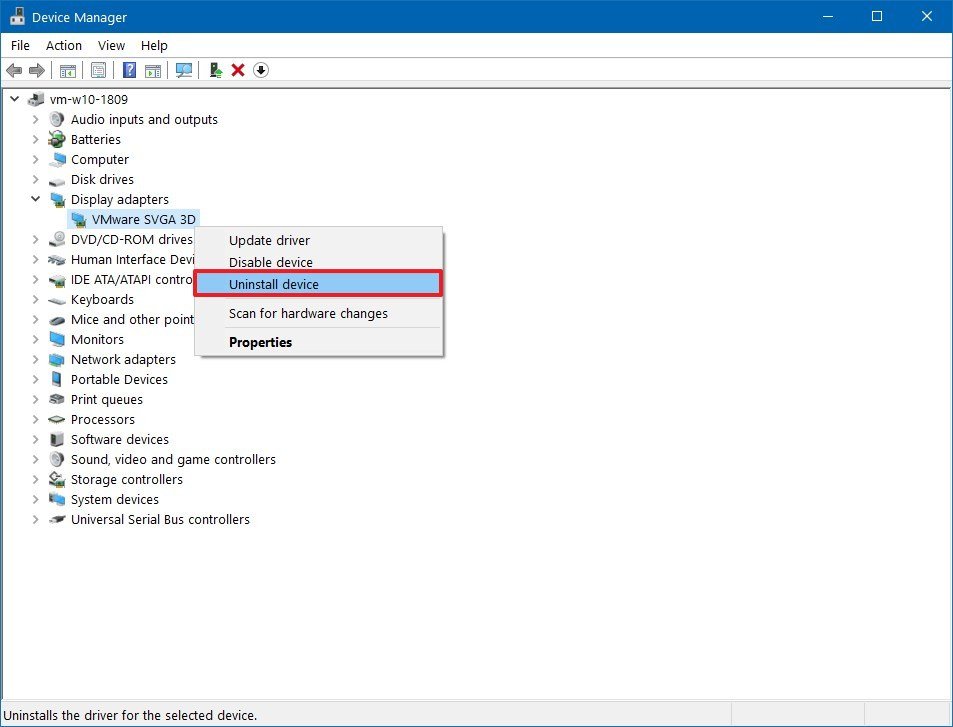
- Click the Uninstall button again.
After completing the steps, you should be able to finish the upgrade of the May 2019 Update without problems.
Other related errors
In addition to error 0x800F0923, you may also see error 0x80070490 - 0x20007 during the installation, which means that one or multiple device drivers are not compatible. If your device gets the error 0x80070003 - 0x20007, then it indicates that the upgrade failed during the driver installation phase.
If you see any of these two errors, after the device rolls back to the previous version, use the above instructions to remove the problematic driver, and then go through the upgrade process one more time.
App compatibility problem
In the case that you're dealing with a compatibility issue with an app, then make sure to download the latest update from your vendor support website. Or remove the app using these steps:
- Open Settings.
- Click on Apps.
- Click on Apps & features.
- Select the app you want to remove, and click the Uninstall button.
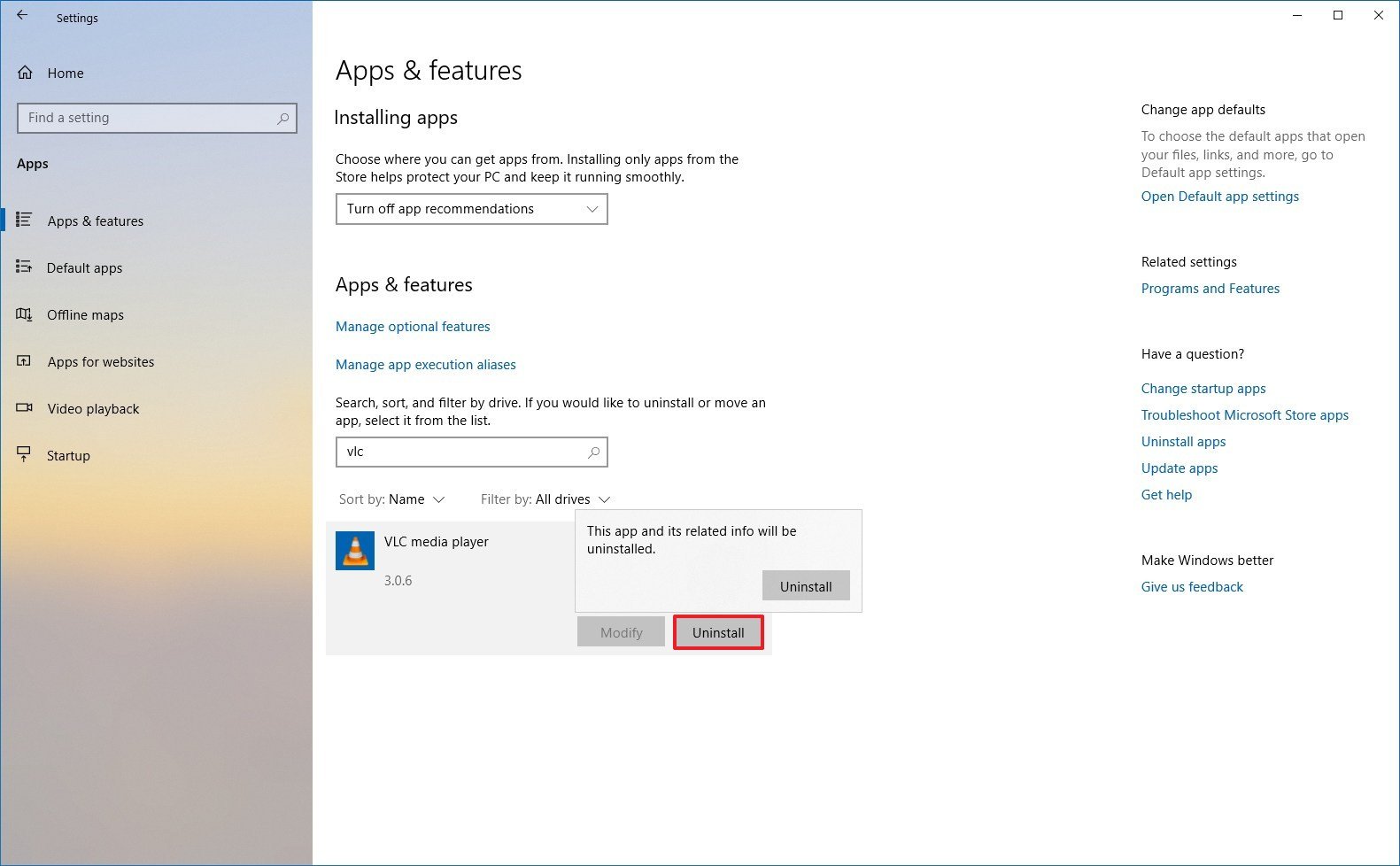
- Click the Uninstall button again.
- Continue with the on-screen directions.
Once you complete the steps, proceed with the upgrade, and after the installation, you should be able to reinstall the app again without issues.
How to fix error 0xC1900107 starting upgrade of the May 2019 Update
During the installation process of the May 2019 Update, there's a chance of running into the 0xC1900107 error, which means that you recently upgraded your computer, and a copy of the previous installation still present on the hard drive.
You can get around the issue restarting your computer, and proceeding with the upgrade again. However, if you're still having the problem, then use the Storage settings to delete the previous version manually.
- Open Settings.
- Click on System.
- Click on Storage.
- Under "Storage sense," click the Change how we free up space automatically option.
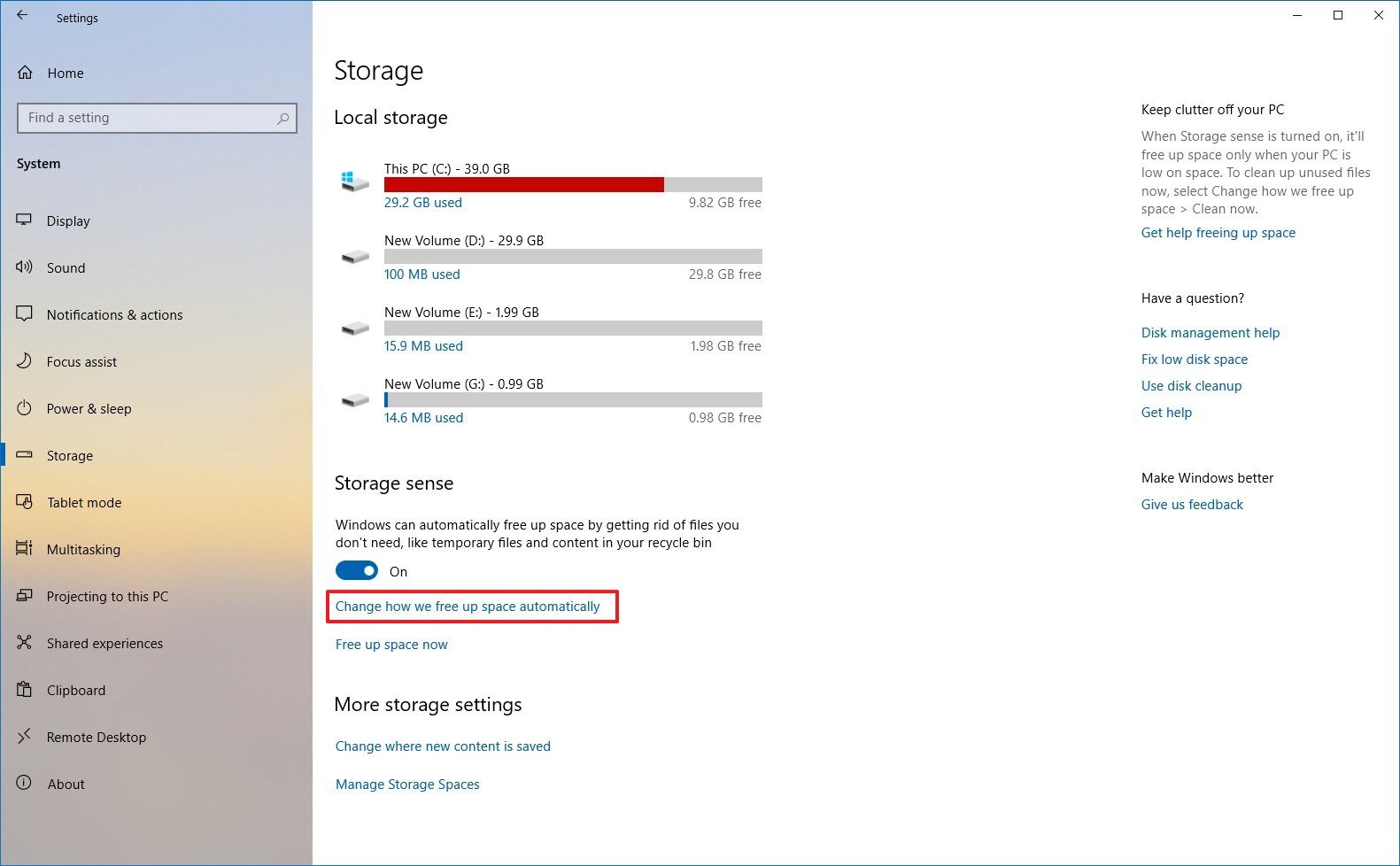
- Under the "Free up space now" section, check the Delete previous versions of Windows option.
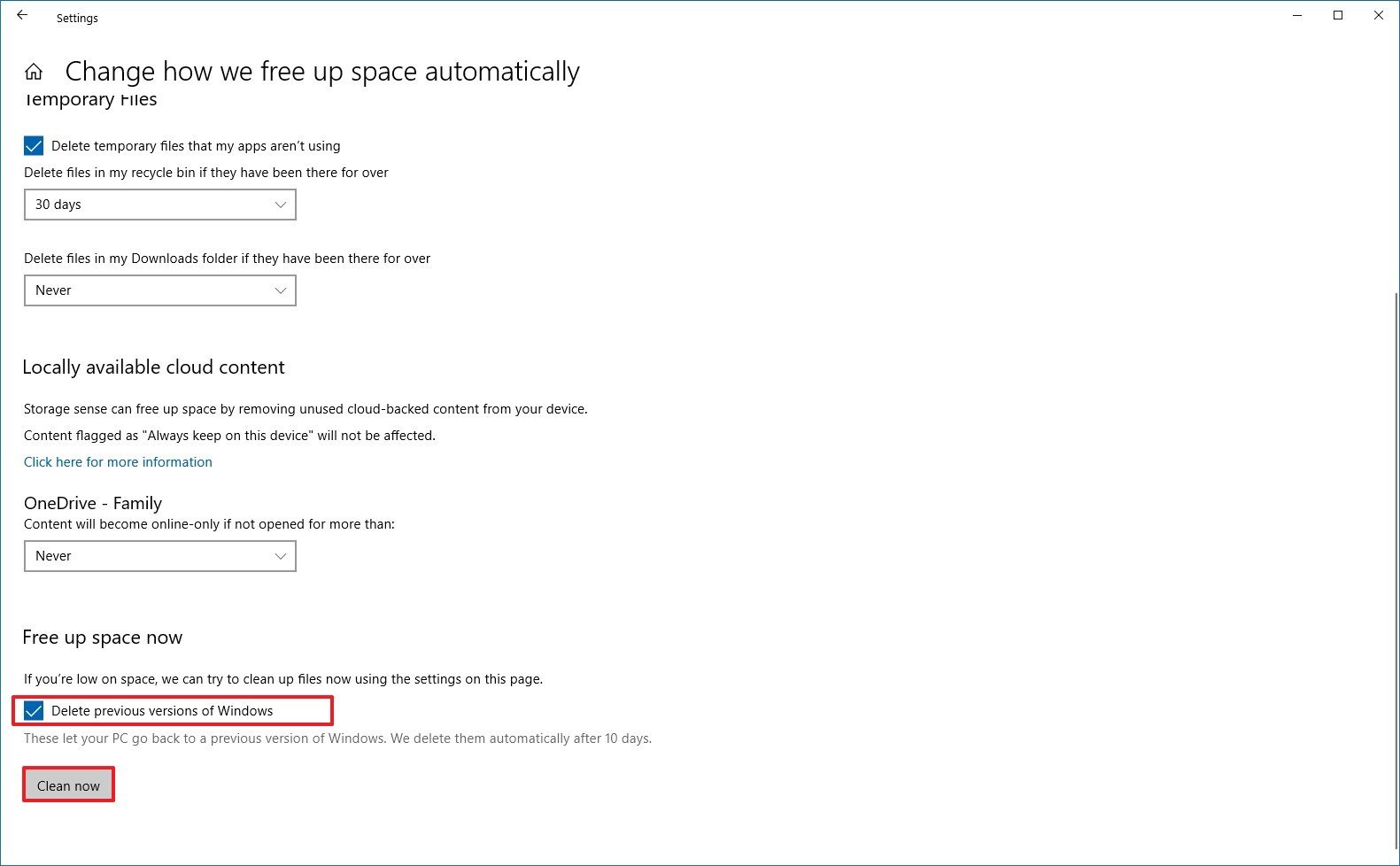
- Click the Clean now button.
After completing the steps, run the setup one more time, and you should be able to upgrade successfully.
How to fix account error 0x80070522 installing the May 2019 Update
When you're trying to install the May 2019 Update, you may also get the 0x80070522 error. If you get this error, it means that the upgrade process has been started from a standard account.
To resolve this issue, sign-in with an administrator account, and rerun the Windows 10 setup one more time. (If you're in a managed environment, you may need to contact your system administrator for assistance.)
How to fix accidental restart error 0x80200056 installing the May 2019 Update
If you get the 0x80200056 error, it means that you may have accidentally restarted your device in the middle of the upgrade process. Thankfully, this isn't a significant problem, you only need to rerun the setup and make sure to keep your computer turned on throughout the entire process.
How to fix activation problems with the May 2019 Update
Windows 10 can reactivate automatically after an upgrade, clean installation, or even after upgrading (some) hardware components as long as it was previously activated. However, sometimes, there's a chance that your copy of Windows 10 won't install after installing the Windows 10 version 1903.
If your computer doesn't activate, you'll end up seeing a "Windows not activated" message along with the 0x803F7001 error in the Activation settings page.
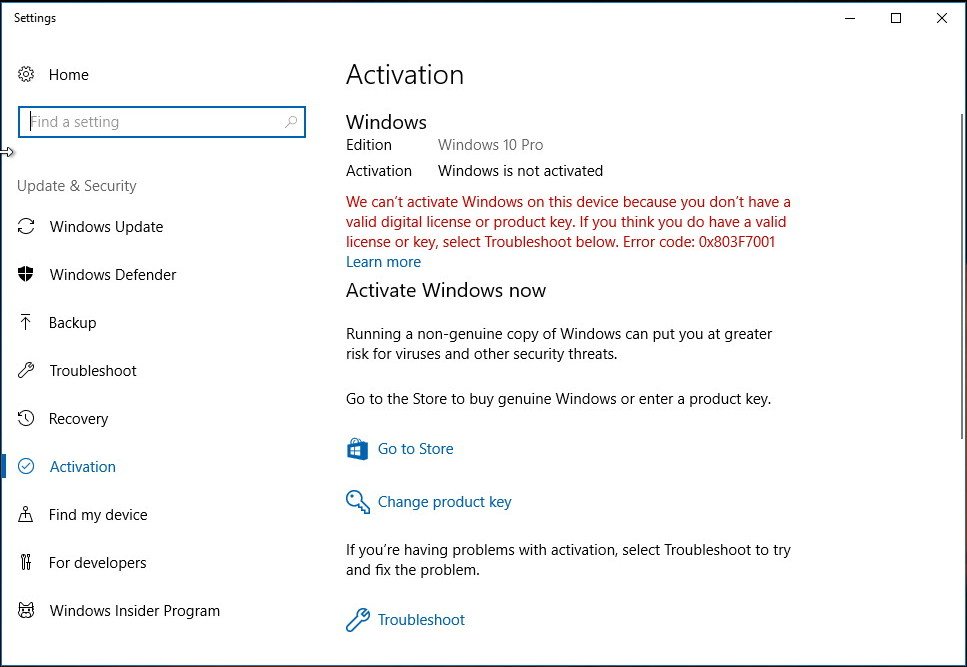
Usually, Windows 10 will reactivate automatically after a few days, but you can use the Activation Troubleshooter to activate immediately.
How to fix networking problems with the May 2019 Update
Although the installation may complete successfully, sometimes, you can end up with networking problems. For example, you may not be able to connect to the internet, or the connection may not be consistent whether you're using an Ethernet or wireless adapter.
When you're dealing with a networking problem, a lot of factors can affect connectivity, such as signal, cable, adapter, settings, driver, router, internet service provider, and even a bug in the new release of Windows 10.
Resolving a network related issue can take a lot of time, but if you're experiencing a problem after upgrading to the May 2019 Update, then it could be a driver or settings problem, which you may be able to fix with these steps:
- Open Settings.
- Click on Network & Security.
- Click on Status.
- Under the "Change your network settings" section, click the Network Troubleshoot button.
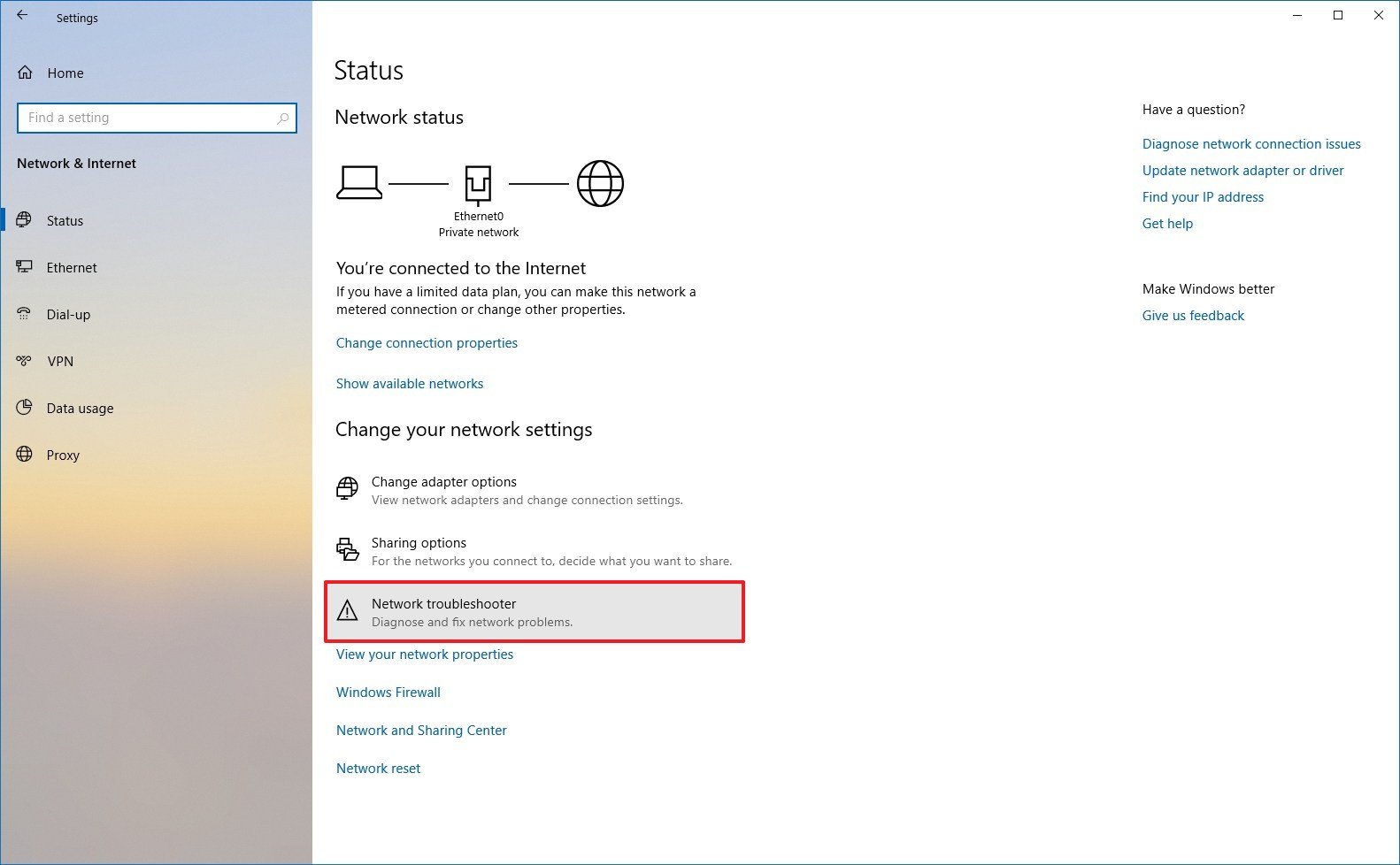
- Continue with the on-screen directions.
Once you complete the steps, you should be able to connect to the internet.
Resetting network adapter settings
If you're unable to connect to the network, you can reset all the network adapters installed on your computer, which you can do using these steps:
Warning: Using these steps will reset all adapters on your device. If you're using a wireless connection, you'll need to re-enter the passphrase to connect.
- Open Settings.
- Click on Network & Security.
- Click on Status.
- Under the "Change your network settings" section, click the Network reset button.
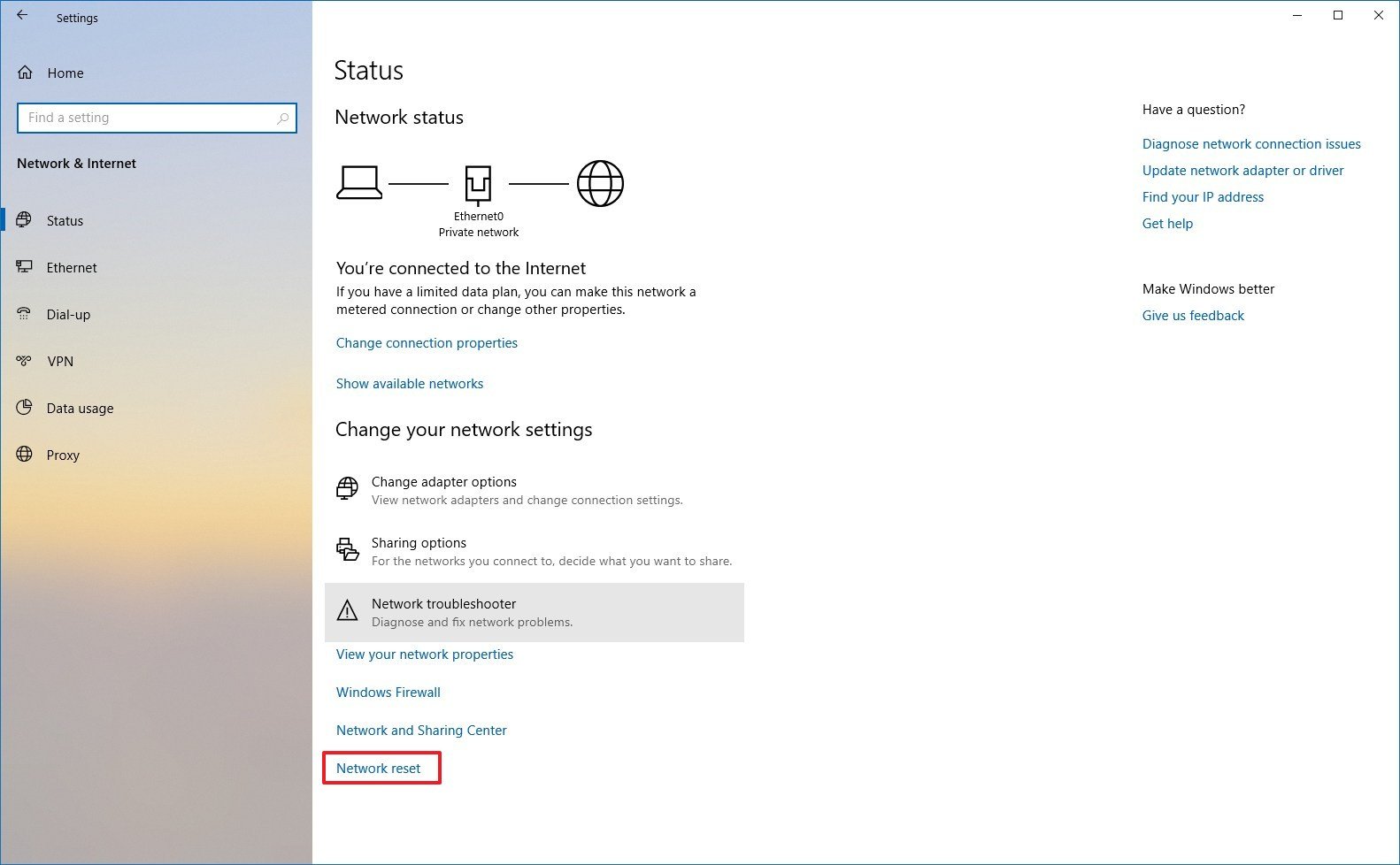
- Click the Reset now button.

After completing the steps, the system will remove and reinstall all the adapters connected to your computer, and it'll reset the settings to their defaults.
In the case that these instructions didn't fix the problem, it could be a bug with the May 2019 Update. You can refer to this guide with tips to overcome most networking problems.
How to fix black screen problems with the May 2019 Update
A black screen can occur during or after installing Windows 10 version 1903. Usually, when you see a black screen, it's a problem with the graphics card driver, one of the internal components, or it could be a previous update that didn't install correctly.
If you're seeing a black screen on your device, you can refer to this guide to troubleshoot and resolve the issue.
In the case the problem persists after the upgrade, the update may not be ready for your device, as such it's recommended to rollback to the previous version using these steps:
- Open Settings.
- Click on Update & Security.
- Click on Recovery.
- Under the "Go back to a previous version of Windows 10" section, click the Get started button.
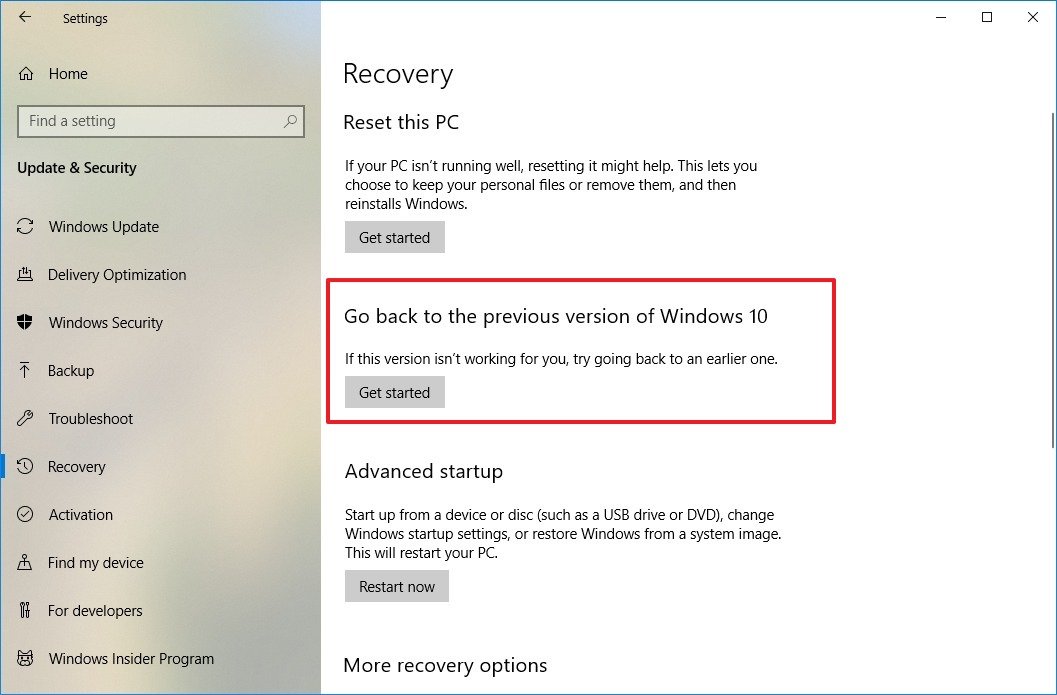
- Select any reason.
- Click the Next button.
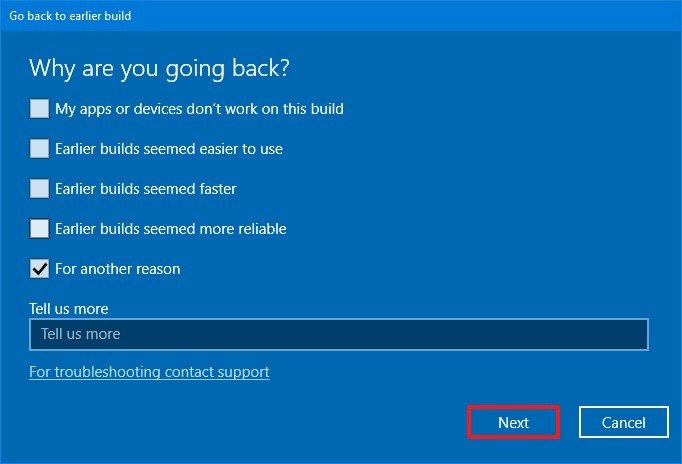
- Click the No, thanks button.

- Click the Next button.
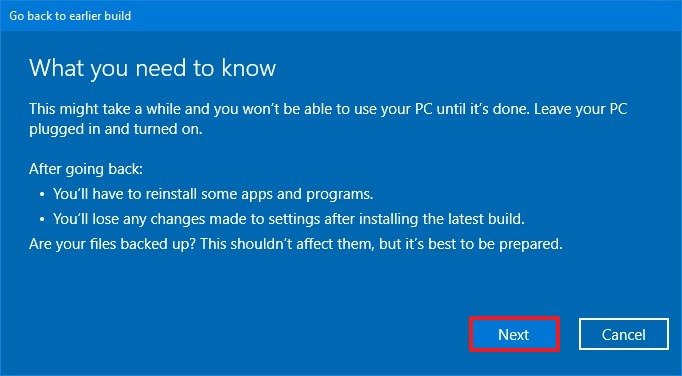
- Click the Next button again.
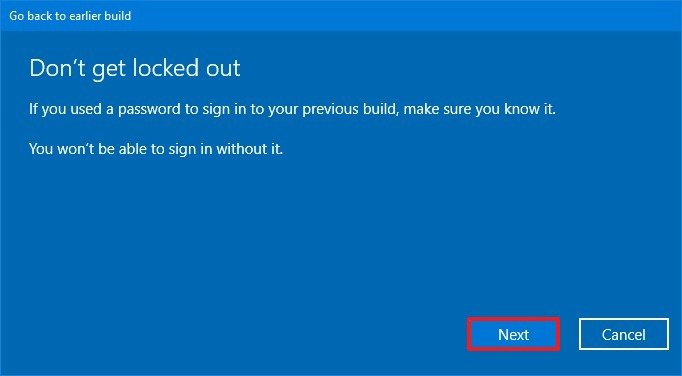
- Click the Go back to earlier build button.
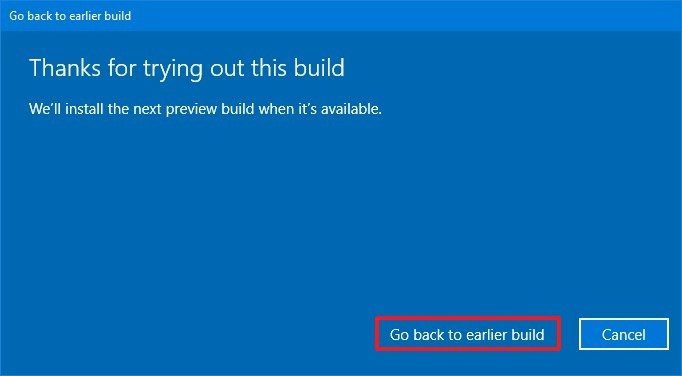
After you complete the steps, you should wait until there's a new update that fixes the problem.
Once you remove the feature update, Windows 10 will try to download it again, but you can use these steps to block the new version until you know for sure that the problem has been fixed.
How to fix Bluetooth issues after upgrading to the May 2019 Update
After installing version 1903, you may encounter problems discovering or connecting Bluetooth devices to your computer. According to Microsoft, the feature update has some issues with some Bluetooth drivers available from Realtek and Qualcomm, and as a result the May 2019 Update won't be offered to affected devices until the problem has been resolved.
If you already upgraded your device using the Media Creation Tool or Update Assistant, the software company is advising to proactively check your computer manufacturer support website for updated drivers.
In the case that an update is available, you should download and install the new versions of driver following your manufacturer instructions. However, if there are no instructions and you need assistance, you can follow this guide to install the driver update.
Also, remember that you need to install Qualcomm drivers greater than version 10.0.1.11, and Realtek drivers greater than version 1.5.1011.0.
How to fix error with external storage upgrading to the May 2019 Update
During the upgrade process to the May 2019 Update, a number of users are reporting the "This PC can't be upgraded to Windows 10" error message.
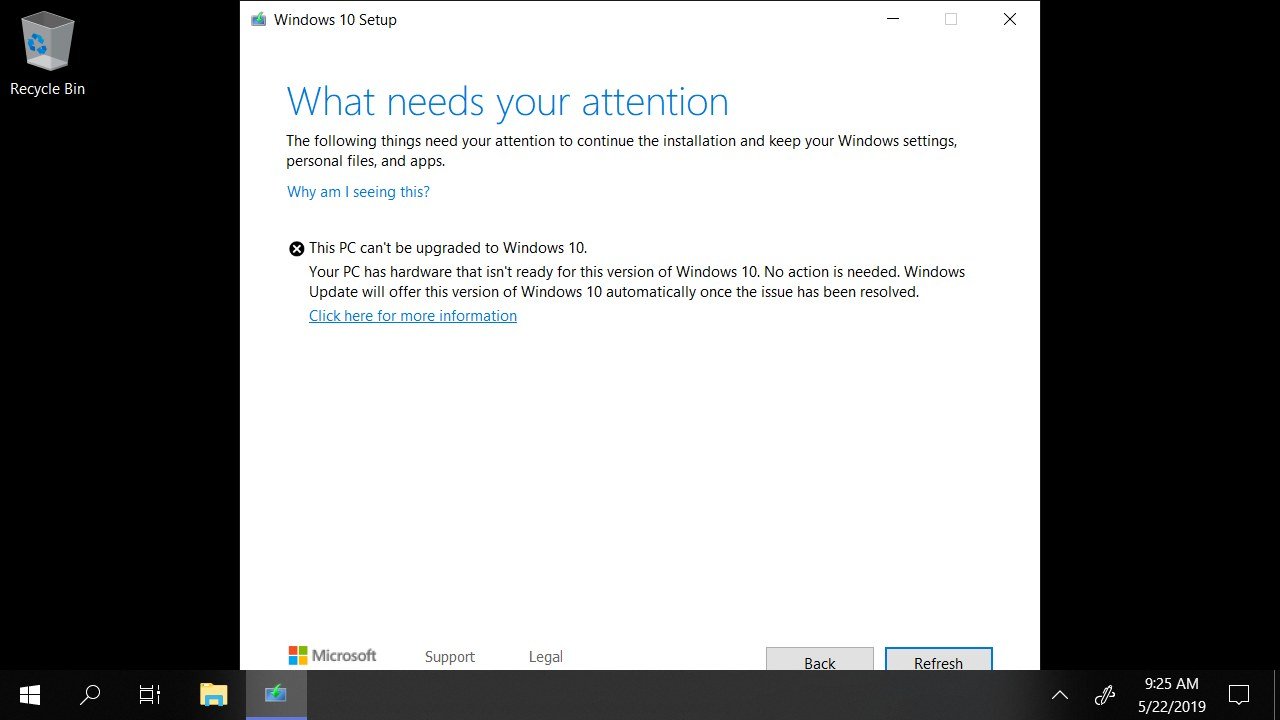
This is a known issue that happens as a result of inappropriate drive reassignment when a USB flash drive, memory card, or secondary internal drive is connected to your computer as you try to install the Windows 10 version 1903.
Microsoft is currently blocking the update on devices that may be affected by this issue until a permanent solution releases. However, if you don't want to wait, to get around this problem, it's recommended to disconnect all external drives as well as secondary internal hard drives from your computer. Then restart Windows 10, and try to upgrade to the May 2019 Update one more time.
How to fix Wi-Fi issues after upgrading to the May 2019 Update
Some users may experience problems, such as intermittent connectivity using a wireless adapter from Qualcomm, after upgrading to the Windows 10 May 2019 Update.
If you have a working internet connection, it's likely that your device is using an outdated version of the Qualcomm driver.
Microsoft is aware of this issue, and it's blocking the feature update on computers using an older version of the driver, as such to get around this issue, you must update the Wi-Fi driver by downloading and installing the latest package from your computer manufacturer using their instructions.
If the support website isn't offering any assistance, download the driver, double-click the ".exe" self-extracting package, or use this guide to extract the content of the ".zip" compressed file, and then use these steps:
- Open Start.
- Search for Device Manager and click the top result to open the experience.
- Double-click the category with the adapter you want to update.
- Right-click the device, and select the Update Driver option.
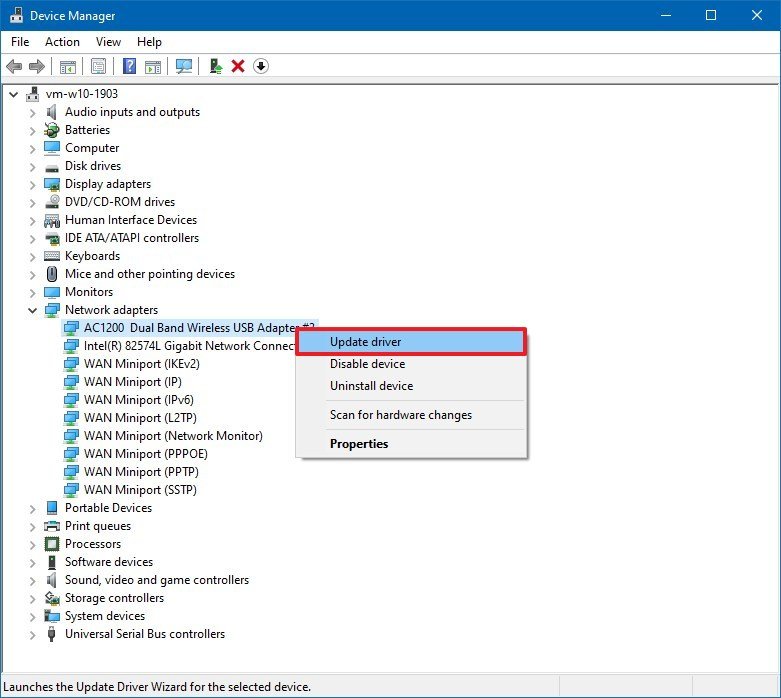
- Click the Browse my computer for driver software option.
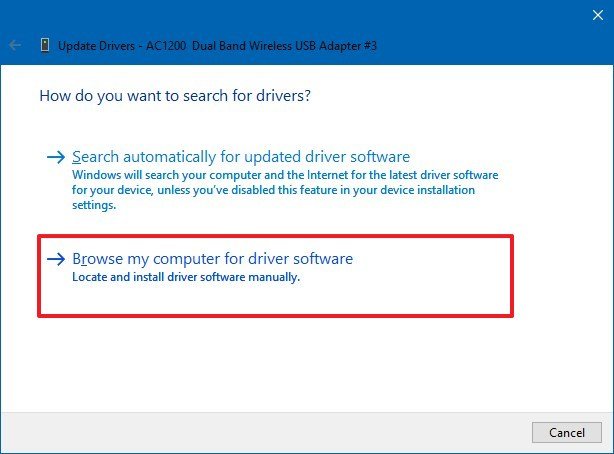
- Click the Browse button.
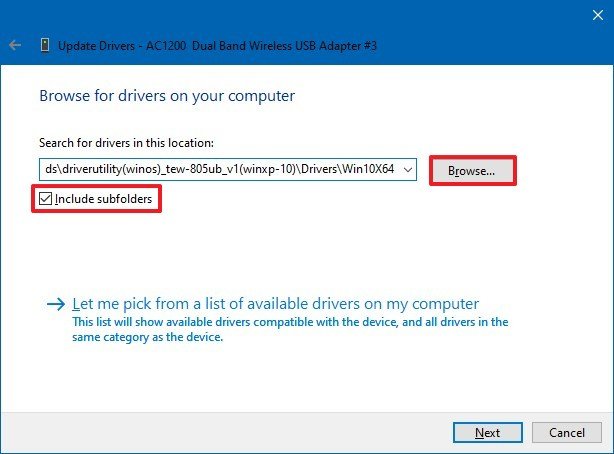
- Select the main folder with the content you have extracted earlier.
- Click the OK button.
- Check the Include subfolders option to allow the wizard to find the correct ".inf" file with the instructions to update the driver.
- Click the Next button.
Once the newer driver has been applied, you can proceed with the installation of the May 2019 Update.
How to fix AMD RAID driver problems upgrading to the May 2019 Update
If you're running an AMD Ryzen system configured in SATA or NVMe RAID mode using an outdated driver (version 9.2.0.105 or lower), when you try to upgrade to Windows 10 version 1903, you'll get the following message:
"A driver is installed that causes stability problems on Windows. This driver will be disabled. Check with your software/driver provider for an updated version that runs on this version of Windows."
And you won't be able to continue with the installation of the feature update.
This is a known issue, and you come across this problem, you should download and install the AMD RAID driver (9.2.0.105 or later) from this AMD support website. (The package contains the driver and PDF file with the instructions on how to set up and update the RAID driver.)
Once the updated driver has been installed, you can proceed with the normal installation of version 1903.
How to fix brightness problem after upgrading to the May 2019 Update
After installing the Windows 10 May 2019 Update (version 1903), users may report issues adjusting the brightness settings. For instance, the brightness settings may apply, but the display won't show any effect.
This is a known issue on devices using Intel display drivers, and Microsoft is currently using a compatibility hold on affected devices until there's a permanent solution.
If you already upgraded to version 1903, and you're experiencing this issue, the workaround is to restart your computer to apply the settings correctly.
How to fix Dolby Atmos audio issues after upgrading to the May 2019 Update
If you recently upgraded your computer to Windows 10 version 1903, you may notice audio loss using Dolby Atmos for headphones and home theater using the extensions downloaded from the Microsoft Store.
This is another known issue, and it happens because an error with the licensing configuration, where the user is unable to connect with the Dolby Access app and enable audio with the extensions.
Devices using this audio configuration will not receive the new version until there's a permanent fix, and there's not a workaround to mitigate this problem.
If you already upgraded your device, you should avoid using Dolby Atmos or remove the feature update until the problem is resolved using these steps:
- Open Settings.
- Click on Update & Security.
- Click on Recovery.
- Under the "Go back to a previous version of Windows 10" section, click the Get started button.

- Select any reason.
- Click the Next button.

- Click the No, thanks button.

- Click the Next button.

- Click the Next button again.

- Click the Go back to earlier build button.

After you complete the steps, you should wait until there's a new update that fixes the problem, and then re-apply the new version.
How to fix night light problems after installing the May 2019 Update
If you are running the May 2019 Update, there's a chance that night light may stop working when connecting to an external display, projector, or dock. When rotating the screen. Or when making any changes to the display settings.
According to Microsoft, this is a known issue, and it's actively working to offer a permanent solution. In the mean time, the new version won't be offered to devices that may encounter this problem.
However, in the case that you're already running Windows 10 version 1903, it's recommended to turn on and off the feature to try fixing the issue with these steps:
- Open Settings.
- Click on System.
- Click on Display.
- Under the "Color" section, turn on and off the Night light toggle switch.

If you're still having issues, then restart your computer to get night light working again.
How to fix duplicate user folders after installing the May 2019 Update
After upgrading to the latest version of Windows 10, you may find an empty folder with the same of the main profile folder.
According to Microsoft, this behavior occurs if you previously redirected you account folders (Desktop, Documents, or Pictures) to a different location using the File Explorer settings, OneDrive wizard to backup those locations, or selecting the option to keep your files using the Out-of-Box-Experience (OOBE) after installing Windows 10.
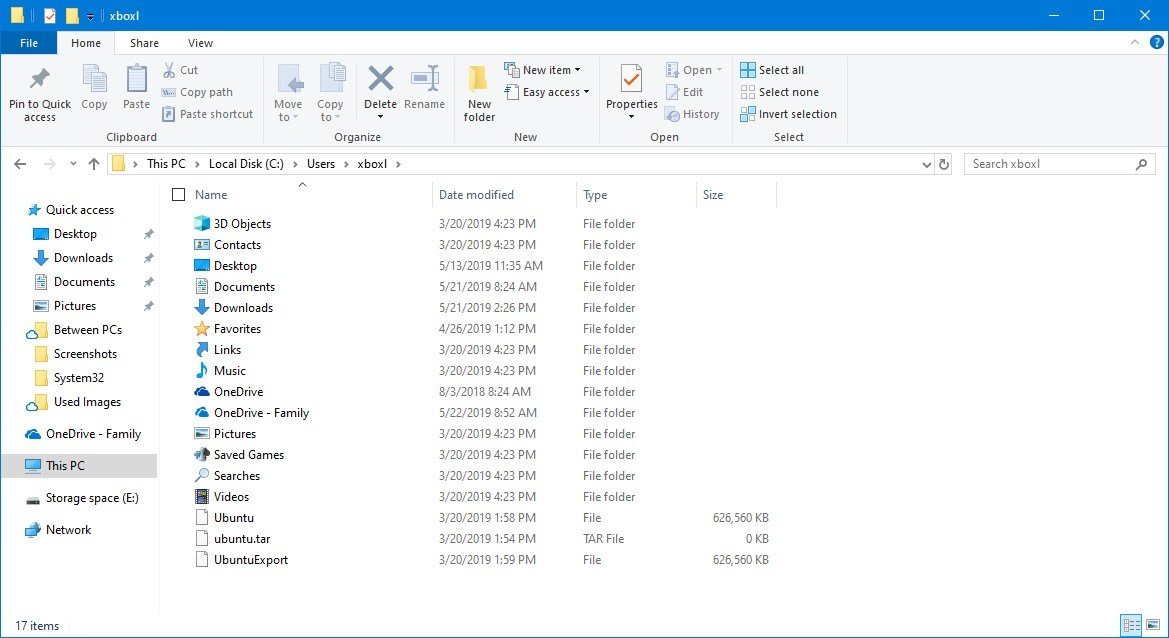
Microsoft is currently investigating the issue, and even though, this issue doesn't cause data loss, the company is promising an update to permanently resolve this issue. Also, devices that include redirected folders now have a compatibility block to prevent the feature update from installing until there's a permanent fix.
How to fix battery drain with the Windows 10 May 2019 Update
If you recently attempted to upgrade your laptop or tablet, you probably came across the "intcdaud.sys" or "What needs your attention" notification during the process.
Microsoft is aware of this issue, and it appears because there's an issue with the Intel Display Audio device drivers (versions 10.25.0.3 through 10.25.0.8) that may result in higher then normal battery drain.
The company is currently working with Intel to resolve the issue permanently. In the meantime, the company is advising to cancel the installation by clicking the Back button in the wizard if you receive the warning. Otherwise, if you try to upgrade, the installation will fail and revert back to the previous version.
How to fix Windows Sandbox error 0x80070002 with the May 2019 Update
After installing the May 2019 Update, some users are reporting "ERROR_FILE_NOT_FOUND (0x80070002)" trying to initialize Windows Sandbox.
According to Microsoft is an error that may appear on devices that changed the system language during the upgrade process to version 1903. The company is currently working to permanently fix this issue with an upcoming update, but if you must address the problem immediately, you can perform an clean installation with these instructions to get around the "ERROR_FILE_NOT_FOUND (0x80070002)."
How to properly upgrade to the Windows 10 May 2019 Update
Although Microsoft aims to offer the best possible upgrade experience, the process to build a new version of Windows 10 that is compatible with countless hardware and software configurations is difficult, and it can result in many unexpected problems during and after the installation.
However, it doesn't mean that you should never upgrade your device, as new releases bring new features, fixes, and usually improve many security aspects. If you plan the installation properly, the chances of running into issues and errors will be significantly lower.
Below we share several tips to minimize the impact as you try to install the May 2019 Update on your computer.
Create a temporary backup
A full backup is your best friend when installing a new version of Windows 10. While the setup process has a mechanism to restore the previous version in case something goes wrong during the upgrade process, there's always a chance of something unexpected will happen. Case and point, during the October 2018 Update rollout, Microsoft was forced to halt the deployment of the update due to a number of bugs, including a problem that caused data loss to a small number of users.
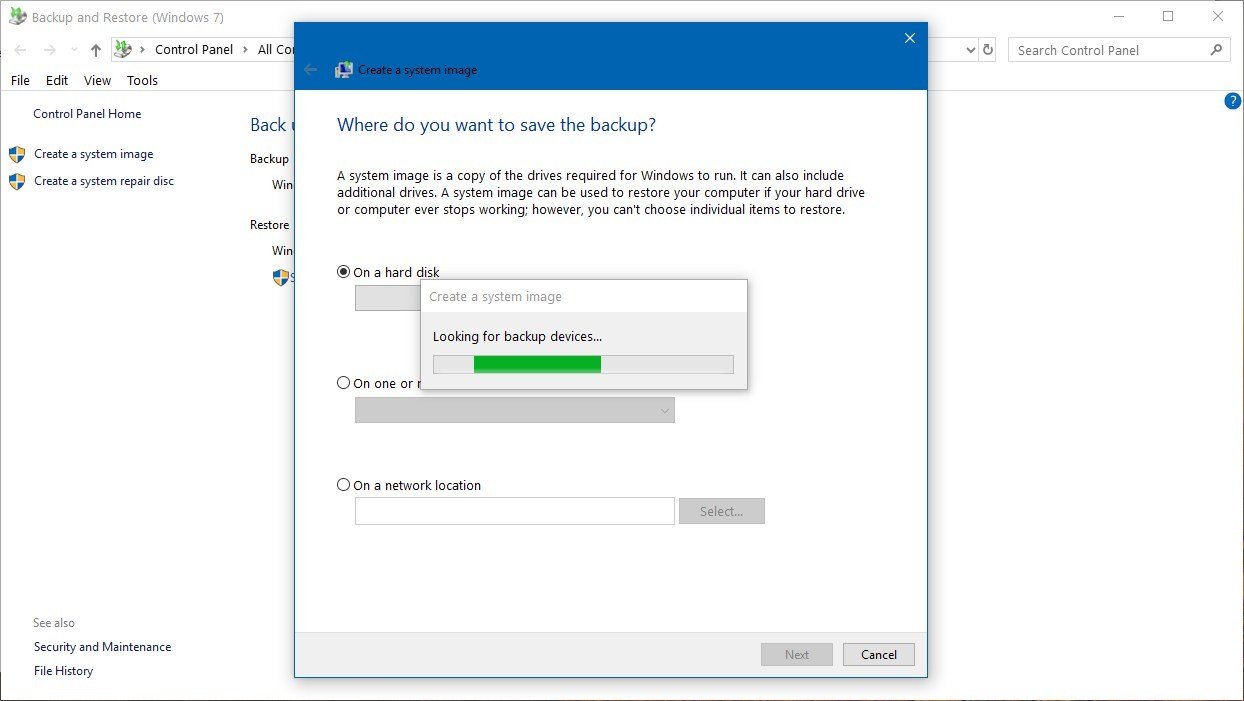
Instead of rushing into clicking the Install button, you should use the built-in imaging tool to create a temporary backup, which you can then use to recover your system if you run into problems after installing the May 2019 Update. Or you should at least backup your personal files to an external drive or to the cloud using OneDrive.
Undo blocking settings
If you're using custom system settings, there's a chance that one of the settings is blocking your computer from getting the Windows 10 May 2019 Update.
To check and undo system settings that may prevent your device from downloading the new update, use these steps:
- Open Settings.
- Click on Update & Security.
- Click the Advanced options link.
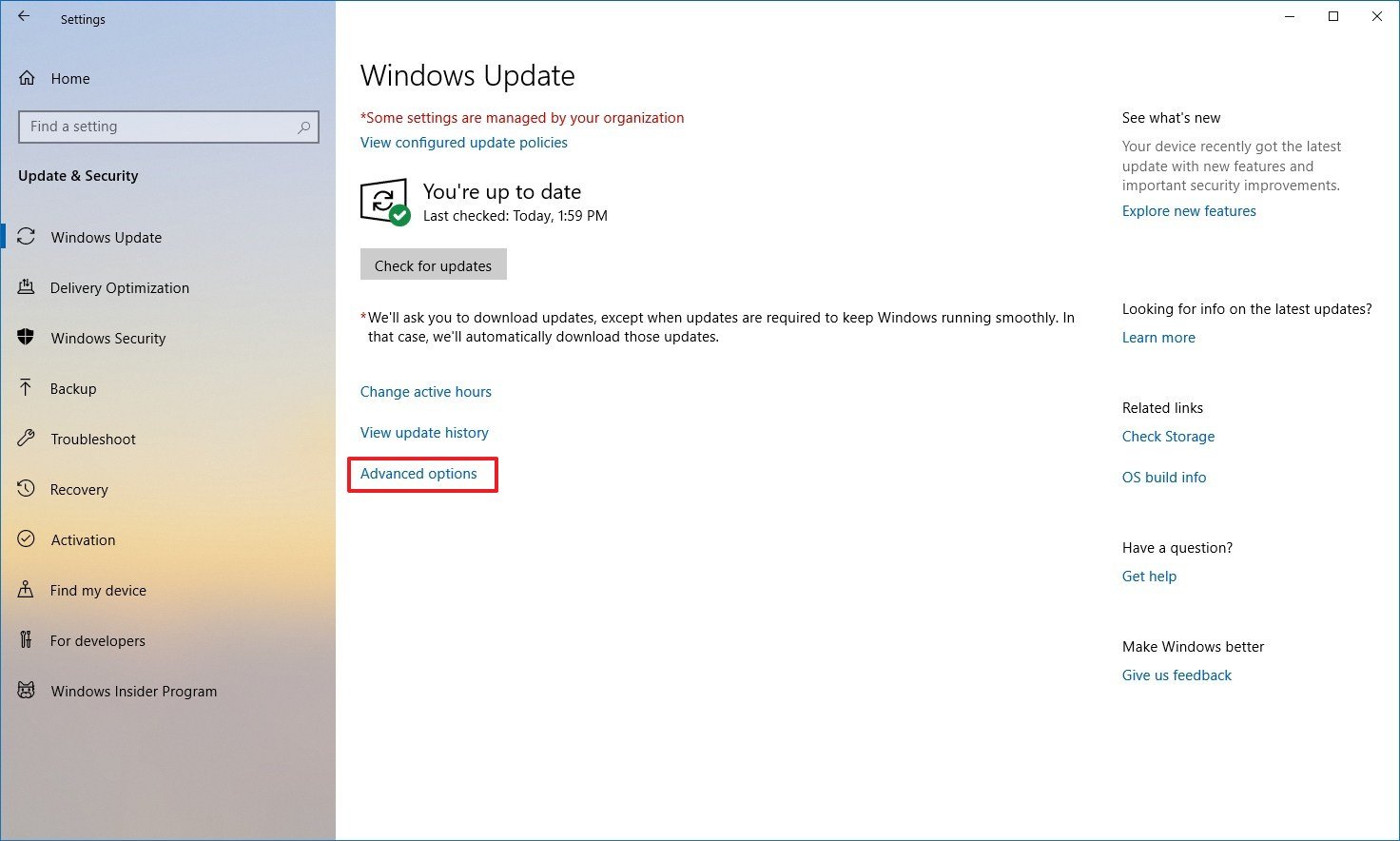
- Turn off the Pause Updates toggle switch.
- Under the "Choose when updates are installed" section, select the Semi-Annual Channel (Targeted) option.
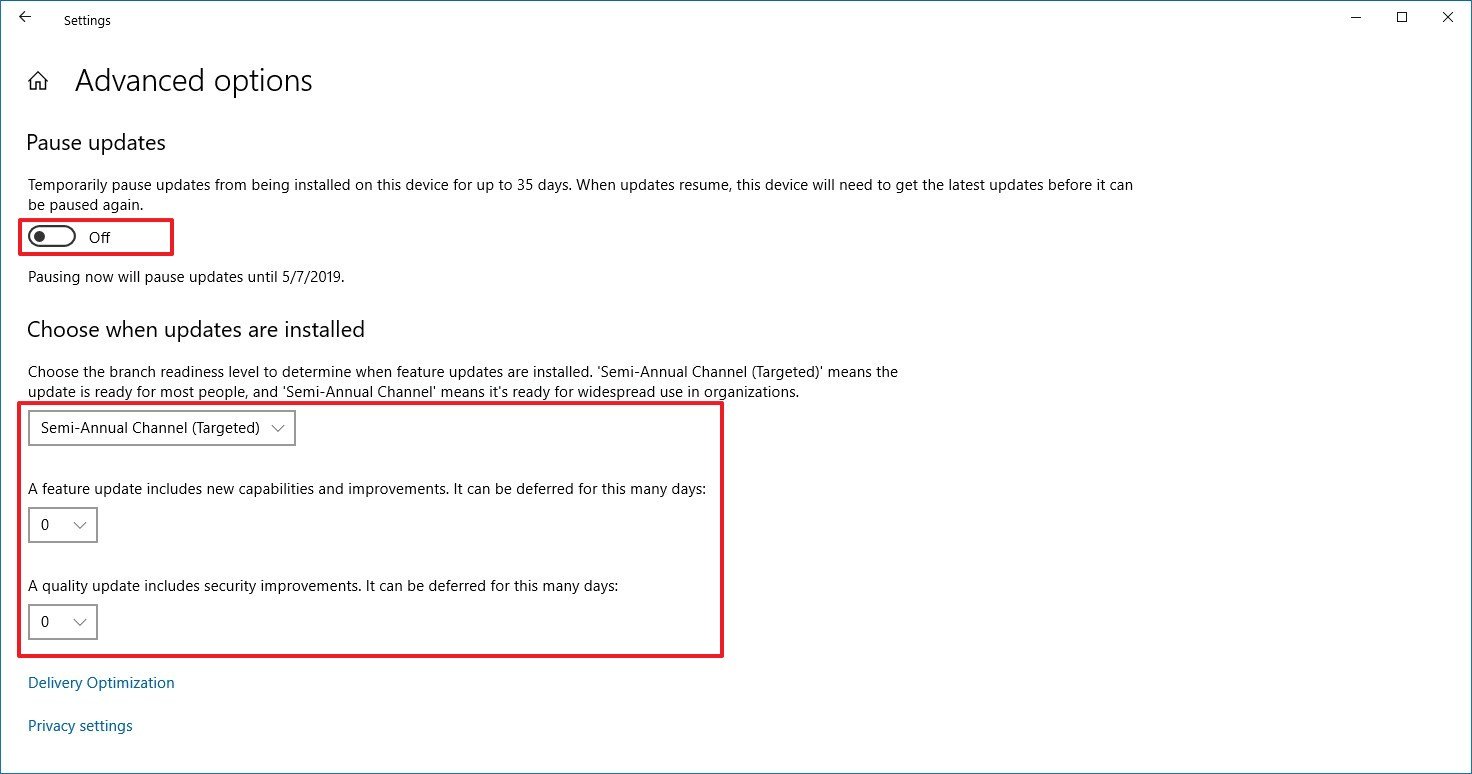
- Use the drop-down menu and select 0 days for both options.
Once you complete the steps, the May 2019 Update should now be able to download and install automatically.
Uninstall non-essential apps
Usually, an upgrade will fail as a result of compatibility issues with outdated or poorly designed applications. If you want to reduce the chances of problems during the installation of the May 2019 Update, make sure to remove apps that are likely to cause problems, such as old classic programs and third-party antivirus.
To remove apps on Windows 10, use these steps:
- Open Settings.
- Click on Apps.
- Click on Apps & features.
- Select the app you want to remove, and click the Uninstall button.

- Continue with the on-screen directions to complete the removal.
Once you complete the steps, you can repeat the instructions to uninstall additional apps.
Disabling antivirus
In addition to old programs, you may want to consider temporarily uninstalling third-party security software, such as antivirus, firewall, and others. After installing the feature update, you can reinstall them back.
Although the risks of leaving your device unprotected during the upgrade process are relatively low, it's assumed that you understand the consequences that it's never recommended to leave your computer without protection.
You should consult your security software vendor for specific instructions. If you're dealing with the Windows Defender Antivirus, you can disable the real-time protection feature using these steps:
- Open Windows Security.
- Click on Virus & threat protection.
- Under the "Virus & threat protection settings" section, click the Manage settings option.
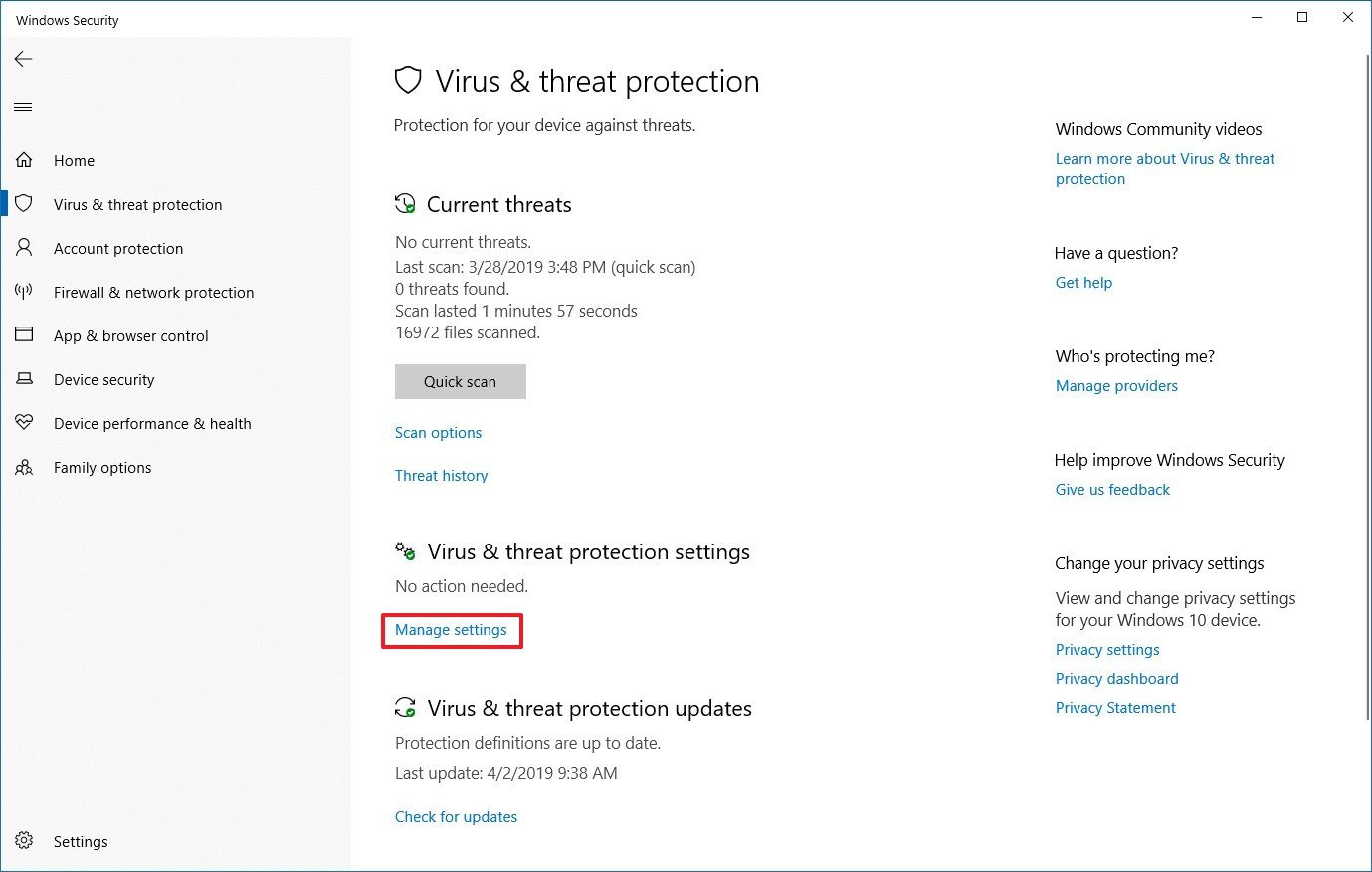
- Turn off the Real-time protection toggle switch.
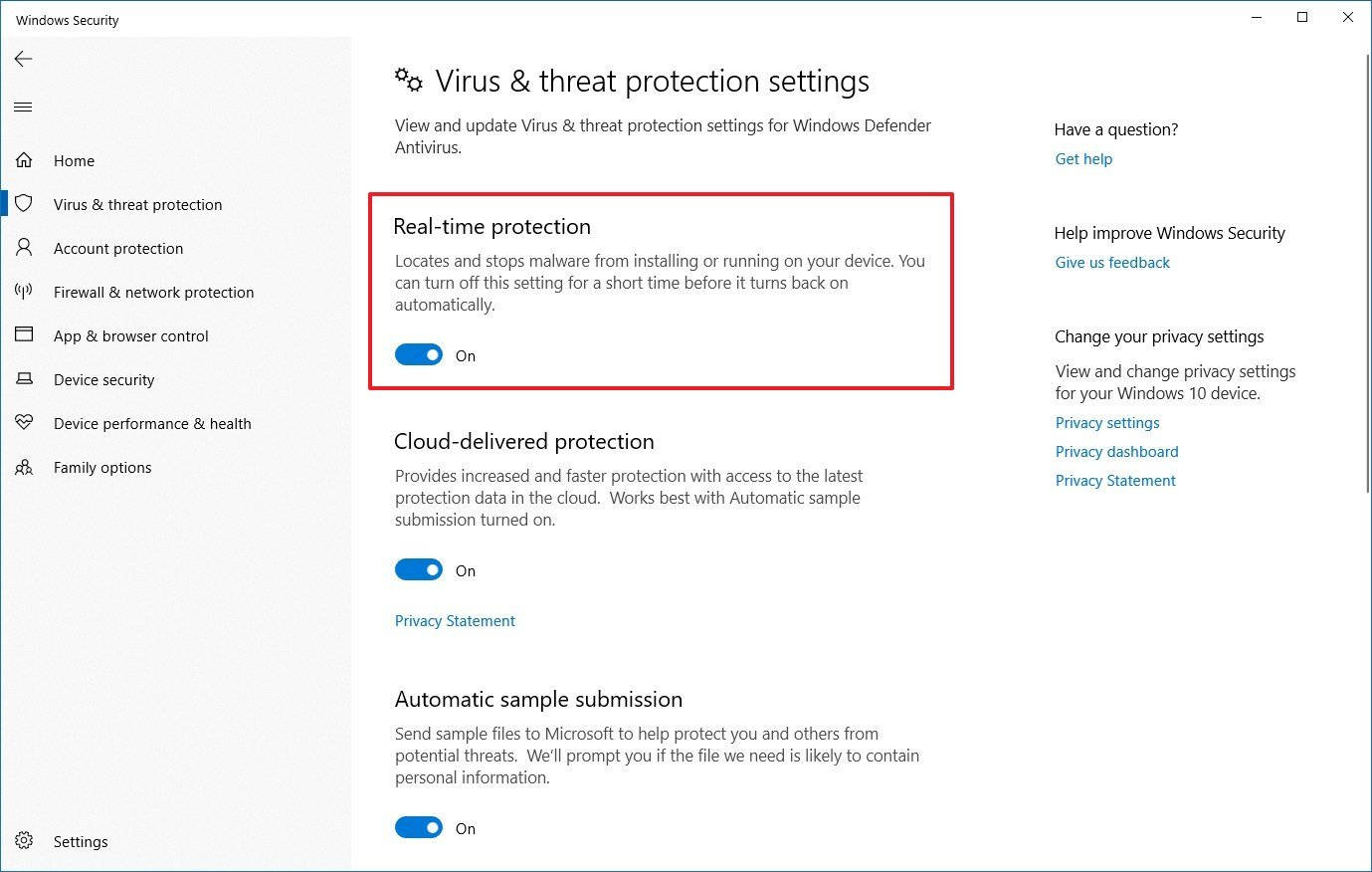
After you complete the steps, the real-time protection will re-enable automatically after the upgrade.
Disconnect non-essential peripherals
A lot of times, the installation for a new version of Windows 10 will fail because of compatibility problems with one or multiple peripherals connected to your device.
You can reduce the number of problems by disconnecting all non-essential peripherals before clicking the Install button. The devices that you want to unplug, include removable storage (such as USB flash drive, SD cards, external hard drives), printers, scanners, dongles, and Bluetooth peripherals.
When preparing to upgrade to the May 2019 Update, you only need a mouse, keyboard, monitor, and an internet connection. After the installation, you can reconnect all the peripherals to your system.
Disable metered connections
A network connection set as a metered to data will block version 1903 from downloading and installing automatically. If you want to upgrade your system to the latest feature update, you have to disable any network connection set as metered.
If you're using a limited internet connection, make sure there's enough data left before removing the configuration or make sure to switch to a network connection that isn't capped before proceeding.
To disable a metered connection on Windows 10, use these steps:
- Open Settings.
- Click on Network & Security.
- Click on Wi-Fi or Ethernet.
- Click the network connection.
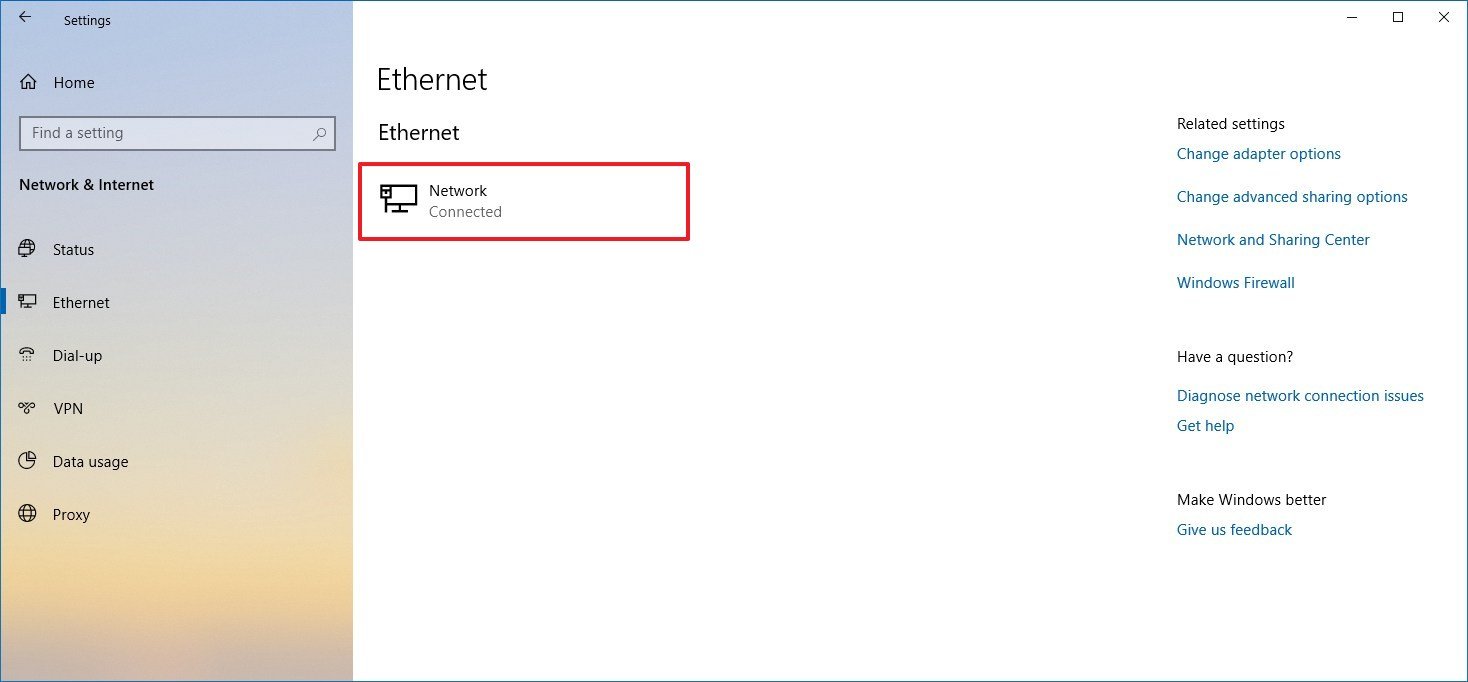
- Turn off the Set as metered connection toggle switch.
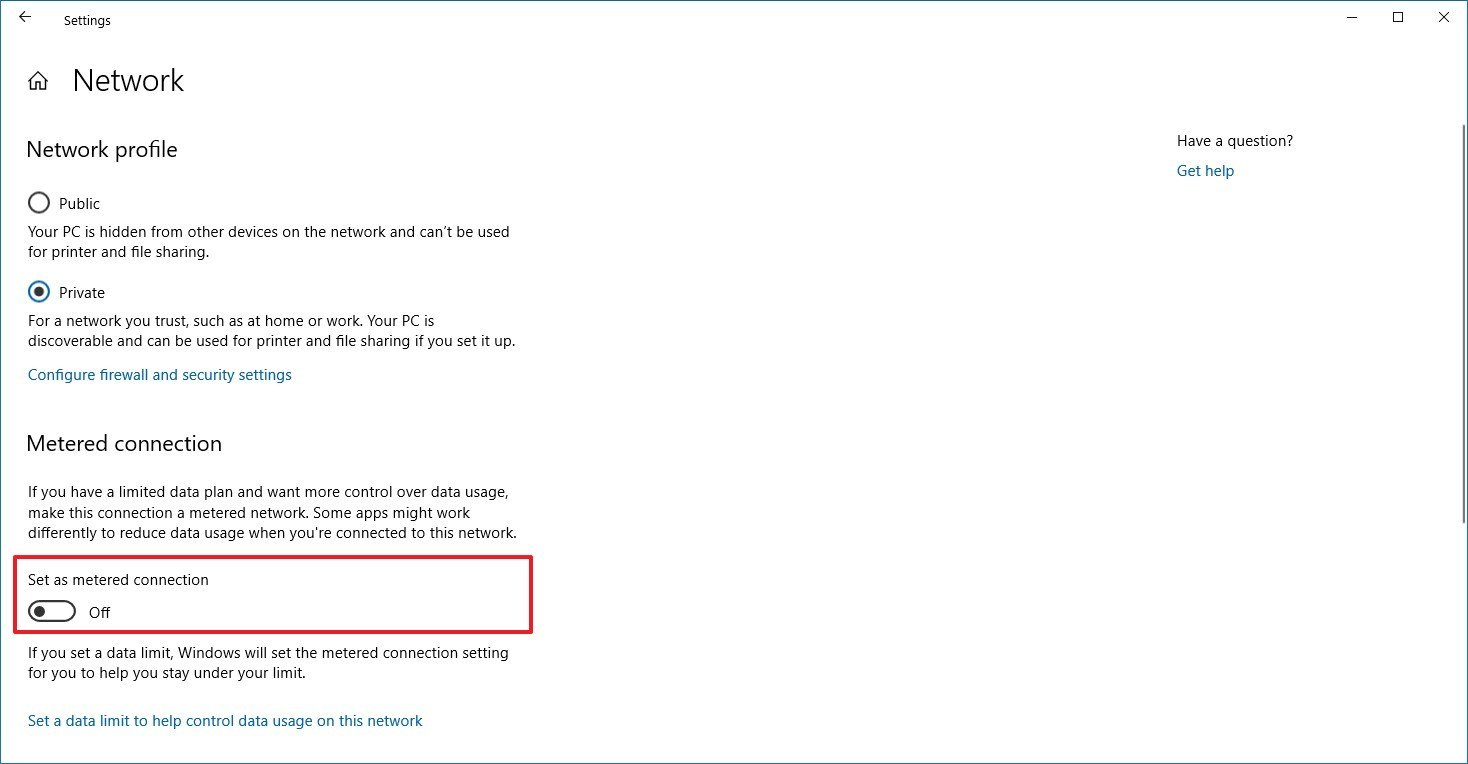
After completing the steps, use Windows Update to download and install the new feature update on your device.
Turn off the firewall
Sometimes the Windows 10 or third-party firewall can come between your device and the feature update causing errors and other problems. If you're using a firewall, make sure to disable it before proceeding with the installation.
You should consult your security software vendor for specific instructions. However, if you're using the Windows Firewall, you can use these steps to disable the feature:
- Open Windows Security.
- Click on Firewall & network protection.
- Click the network with the "active" label.
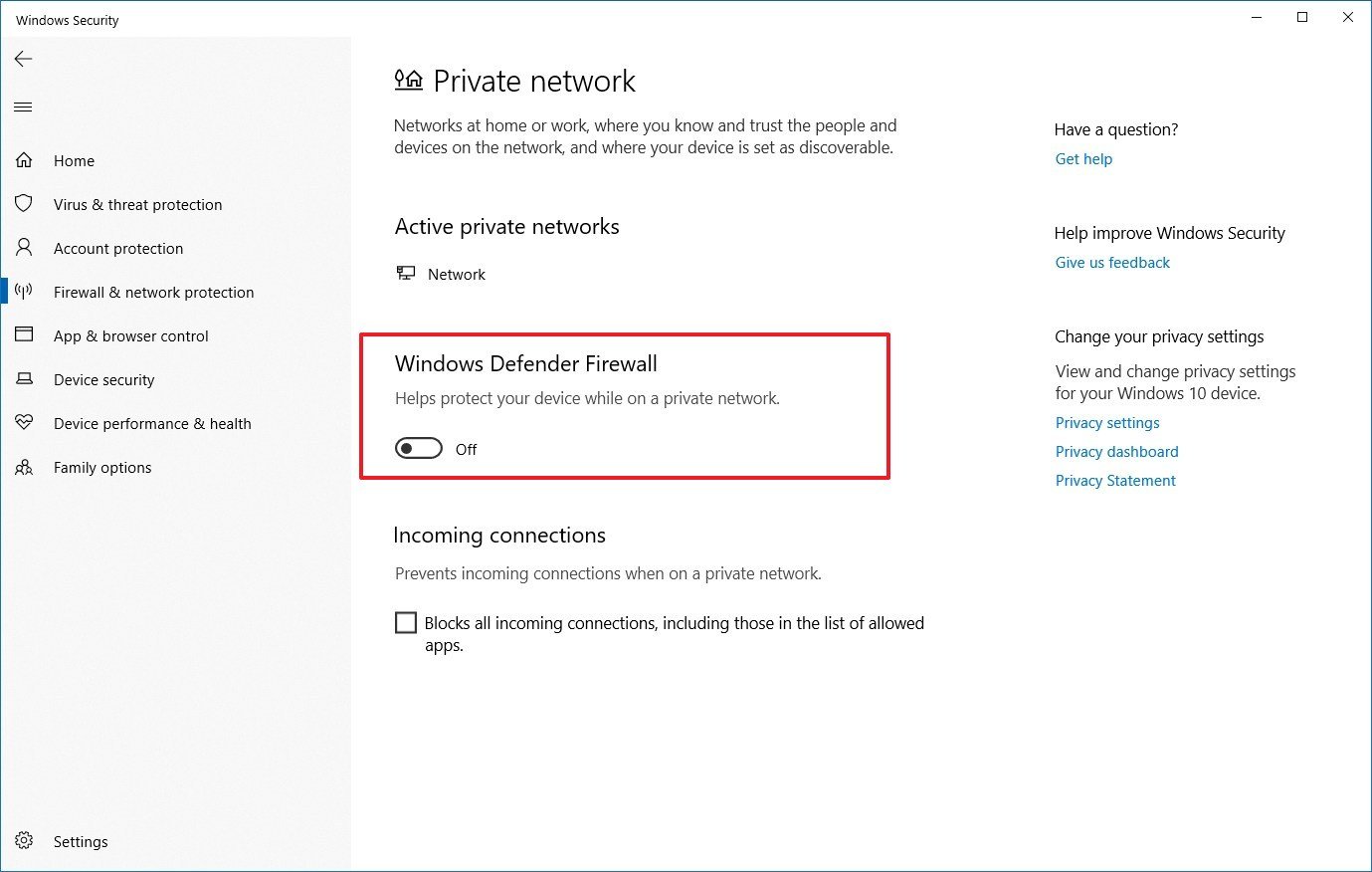
- Turn off the Windows Firewall toggle switch.
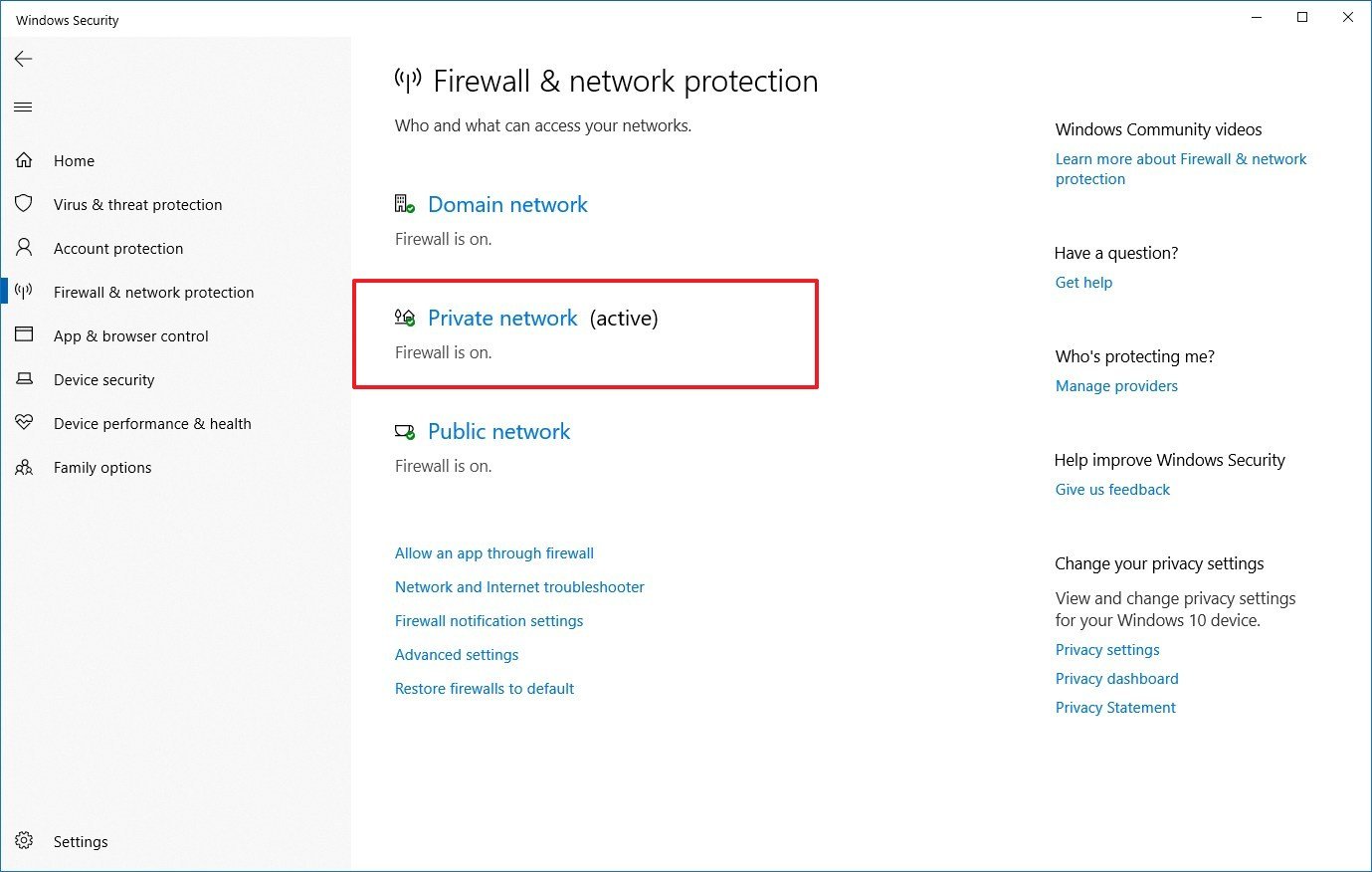
Once you complete the steps, your device should be able to download the upgrade files without issues.
Upgrade using clean installation
If you've followed all our recommendations, and you're still unable to install Windows 10 version 1903, then you should consider performing a clean installation.
When you use a clean installation, you'll erasing everything and installing a fresh copy of Windows 10 with the latest feature update, which can help to resolve performance and many other issues.
If you want to try a clean installation, you should use the Media Creation Tool to create a USB media, which you can use to boot your computer and complete the setup. You can find all the steps to perform this task in this guide.
Wrapping things up
While the first semi-annual update for Windows 10 is now rolling out to compatible devices with new features and improvements, remember that when a major release becomes available (at least during the early days) unknown bugs and compatibility issues are expected.
If you're planning to install version 1903 immediately after the official launch, before rushing into the process, keep in mind that Microsoft always recommends waiting until the update downloads to your device automatically. The reason is that using Windows Update, the company can more accurately scan and detect if your configuration is compatible with the new feature update, which can save you a lot of headaches.
Did you come across any problems installing version 1903? If so, how did you fix the issue? Let us know in the comments.
More Windows 10 resources
For more helpful articles, coverage, and answers to common questions about Windows 10, visit the following resources:
- Windows 10 on Windows Central – All you need to know
- Windows 10 help, tips, and tricks
- Windows 10 forums on Windows Central
Mauro recommends all these affordable accessories
Hi, I'm Mauro Huculak, Windows Central's help and how-to guru. I wrote the post you're reading now, and I know the Windows OS inside and out. But I'm also a bit of a hardware geek. These are some of the affordable gadgets on my desk today.
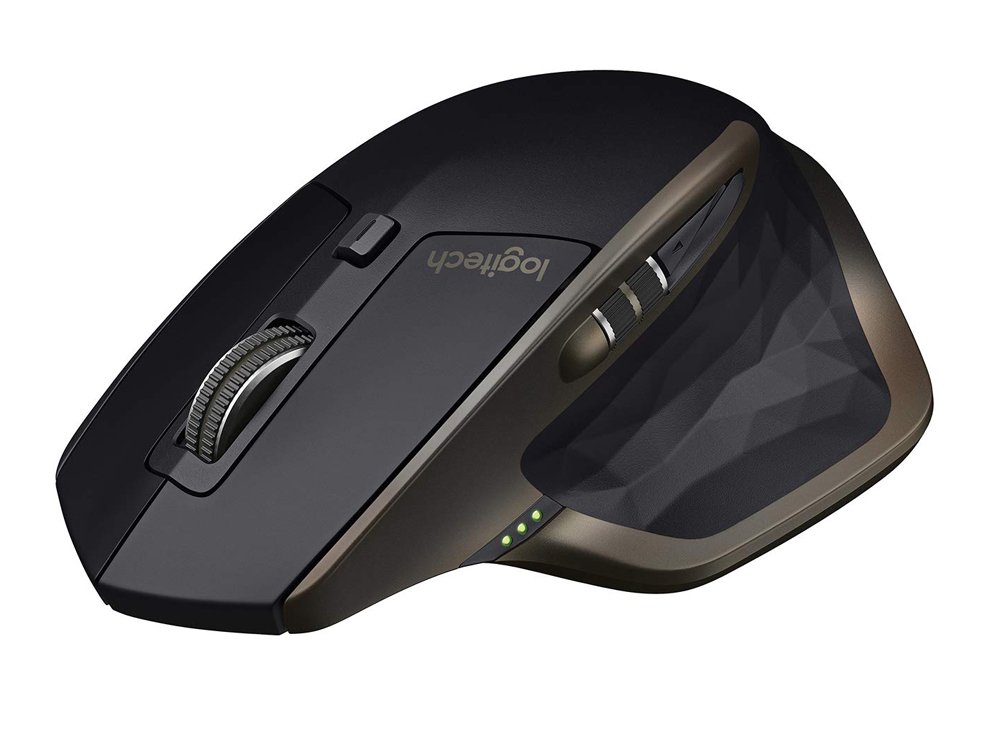
Logitech MX Master Wireless Mouse ($72 at Amazon)
I know mice, and this is the one I use every day. The MX Master is a wireless high-precision mouse that's very comfortable to use and has many great features, including the ability to connect with multiple devices, an infinite scroll wheel, back and forward buttons, all of which you can customize.
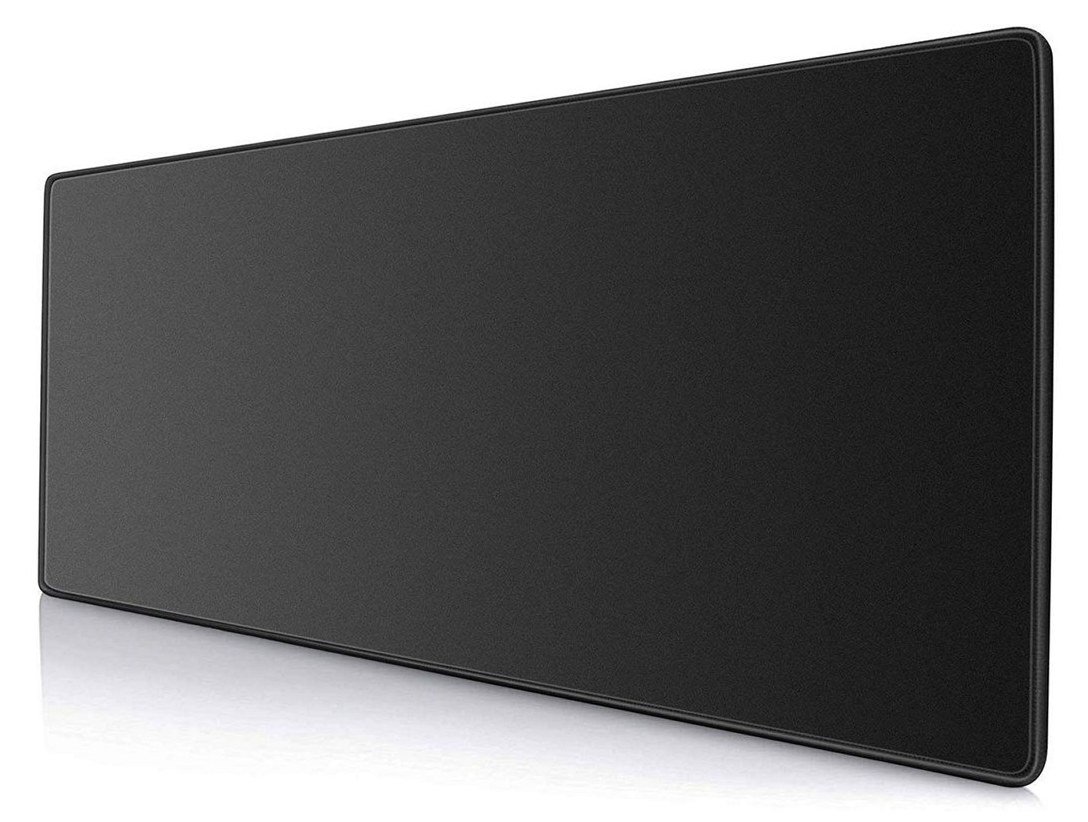
Ktrio Extended Gaming Mouse Pad ($12 at Amazon)
If you spend a lot of time typing, your palms and mouse will leave tracks on your desk. My solution was to start using gaming mouse pads, which are big enough for you to use the keyboard and the mouse comfortably. This is the one I use and recommend.
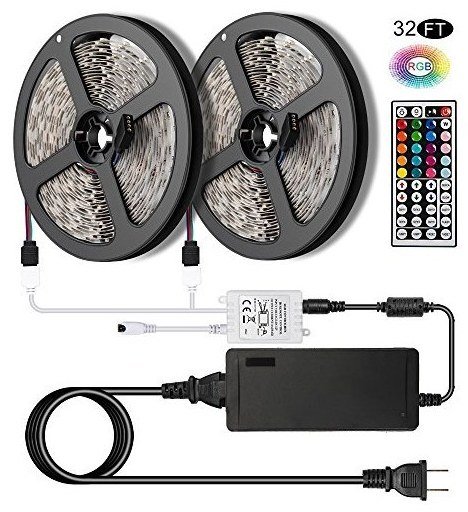
Supernight LED light strip ($20 at Amazon)
You could just use a regular light bulb in your office, but if you want to add some ambient lighting with different colors, an RGB LED strip is the way to go. This one is Mauro-approved.
Mauro Huculak has been a Windows How-To Expert contributor for WindowsCentral.com for nearly a decade and has over 15 years of experience writing comprehensive guides. He also has an IT background and has achieved different professional certifications from Microsoft, Cisco, VMware, and CompTIA. He has been recognized as a Microsoft MVP for many years.

